Introduction
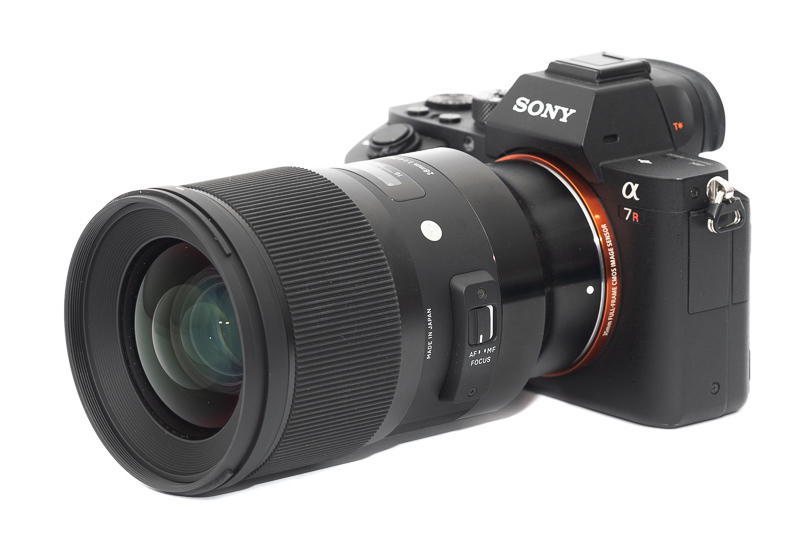
No matter the camera system, 28mm f/1.4 fullframe lenses are a rare breed. And when you are looking for one equipped with autofocus, things really start to look dire. In most cases your only option is this Sigma 28mm 1.4 Art, which is also one of Sigma’s last fast primes designed for DSLRs and one where we still did not see a smaller “DN” mirrorless version. Despite all this, is this still a lens you should consider today? Let’s have a closer look.
Sample Images
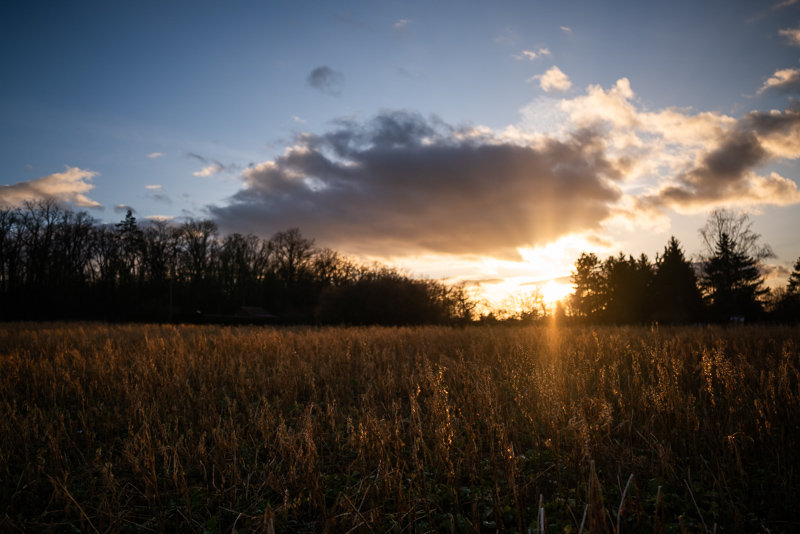

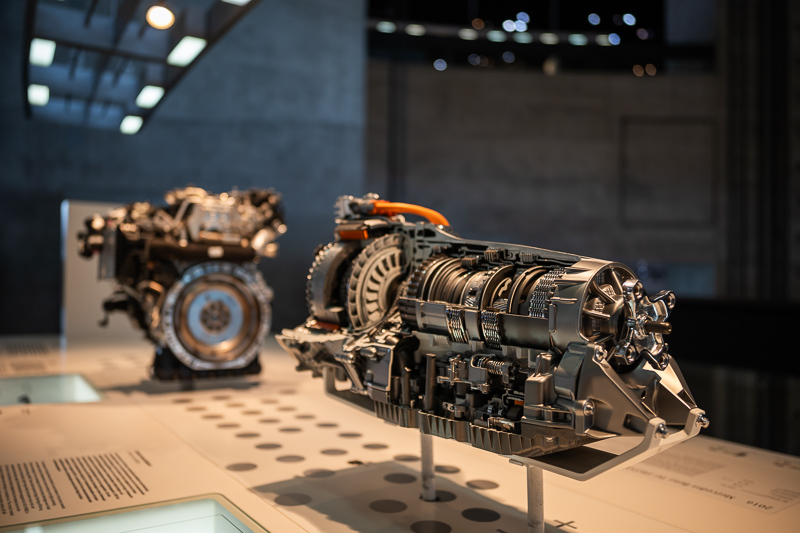
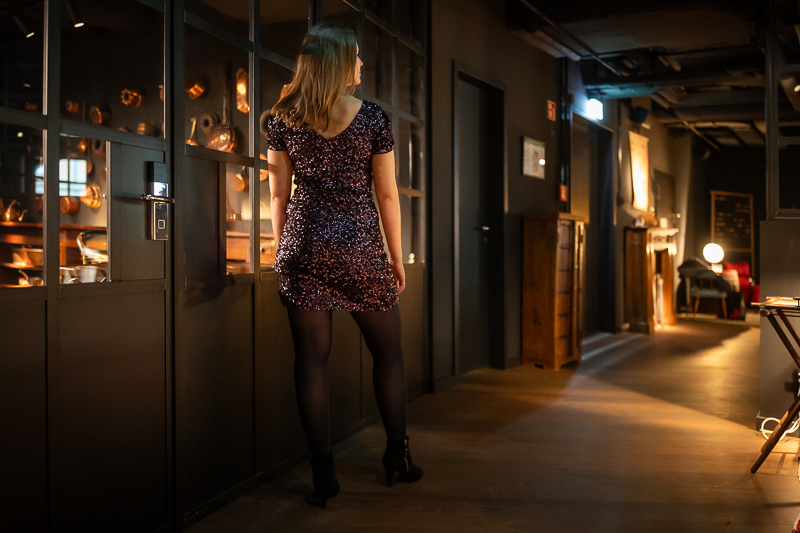
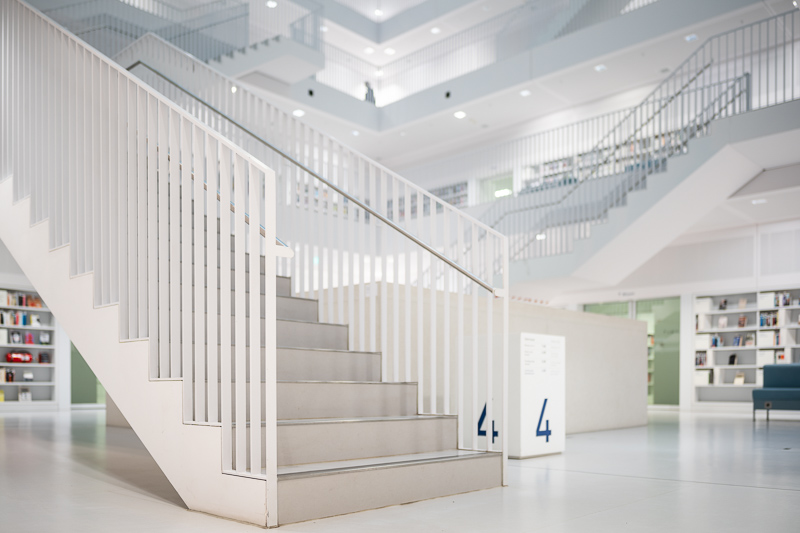
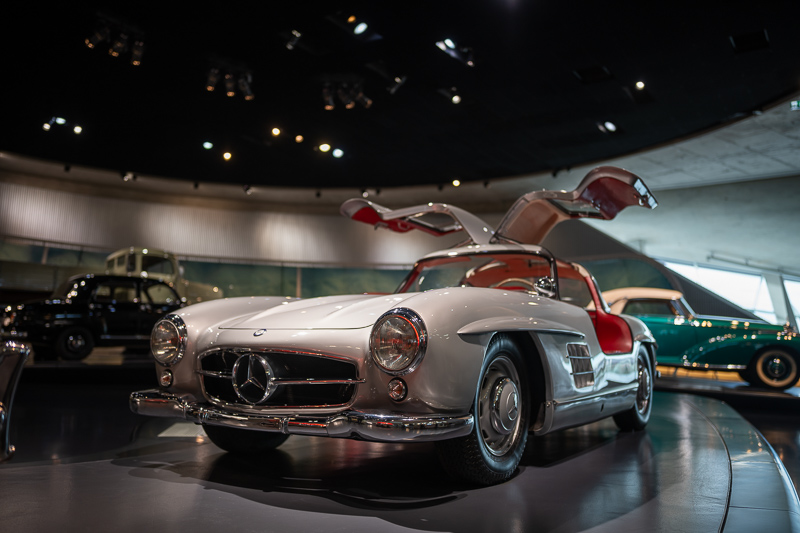

You can find many of the sample images in full resolution here.
Contents
Specifications
The E-mount version of the Sigma 28mm 1.4 Art has the following specifications:
-
- Diameter: 83 mm
- Field of view: 75.4° (diagonally)
- Length: 134 mm
- Weight: 921g (without hood, without caps)
- Filter Diameter: 77 mm
- Number of Aperture Blades: 9 (rounded)
- Elements/Groups: 17/12
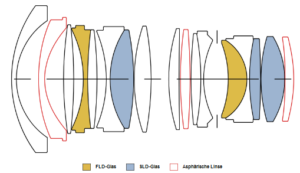
- Close Focusing Distance: 0.28 m
- Maximum Magnification: 1:4.6 (measured)
- Mount: Sony E | Nikon F | Canon EF | L Mount
buy from amazon.com | amazon.de | B&H | ebay.com | ebay.de (affiliate links) for $799 (new) or $550 (used)
Disclosure
This Sigma 28mm 1.4 Art was kindly provided free of charge by one of our readers for review purposes. Thanks a lot!
Handling/Build quality
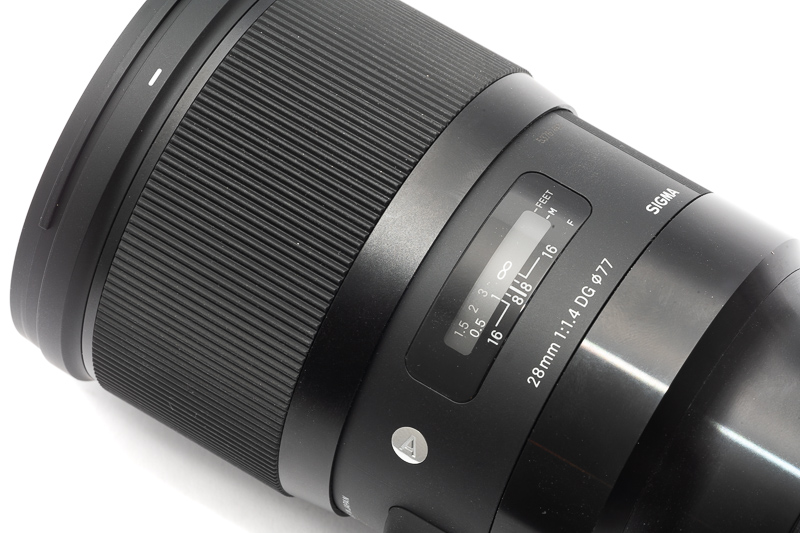
Unlike other native AF lenses for E-mount the former DSLR lenses by Sigma feature a physical distance scale and a direct coupling of focus ring and internal mechanics.
To me this is good news, as coupled with the nice resistance of the focus ring this leads to a nice manual focus experience. The focus throw is a little over 90° which is also acceptable.
The outside is made from the same high quality polycarbonate we already know from the other Sigma Global Vision lenses. I cannot tell you much about the long term reliablity or about the internal parts.
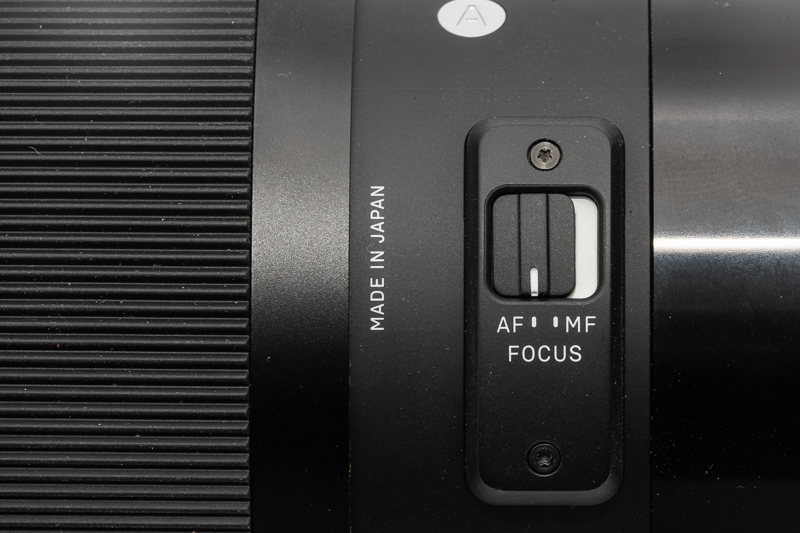
The lens further features an AF/MF switch but no other buttons and no aperture ring.
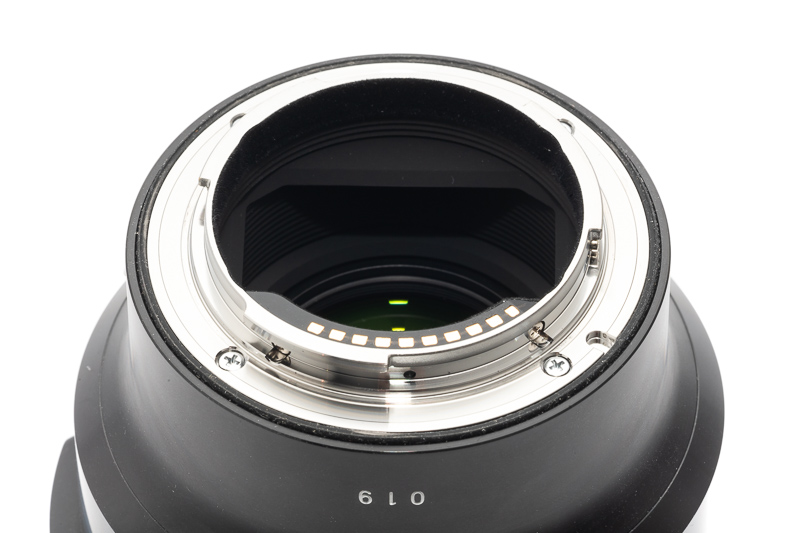
Sigma claims the lens is dust- and splash proof and like all of Sigma’s full frame E-mount lenses there is a rubber gasket to be found at the bayonet.
What I found extremely interesting: the bayonet opening has tiny grooves in the corners of the frame, I think otherwise the bayonet would have led to mechanical vignetting.
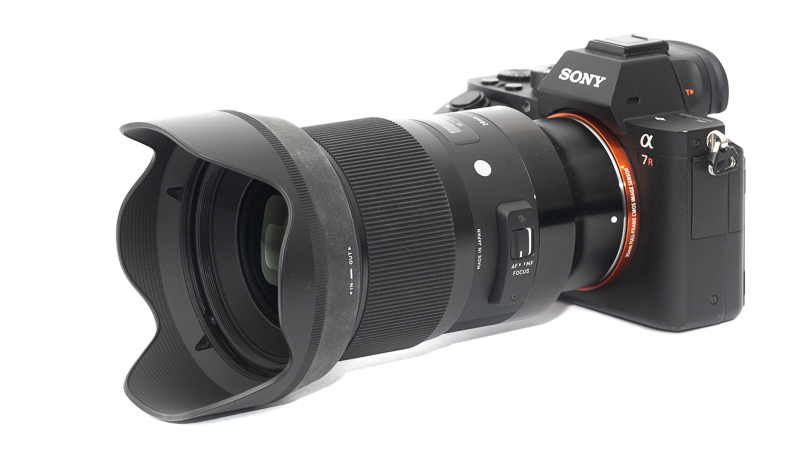
A bayonet type lens hood is also part of the package. It offers the same build quality as those from other high quality Sigma primes from that era (e.g. Sigma 40mm 1.4 Art and Sigma 35mm 1.2 Art DG DN) and as we also know from Sony’s GM series, meaning: it comes with a release button and is made from a mix of polycarbonate and rubber (which is really good at attracting dust).
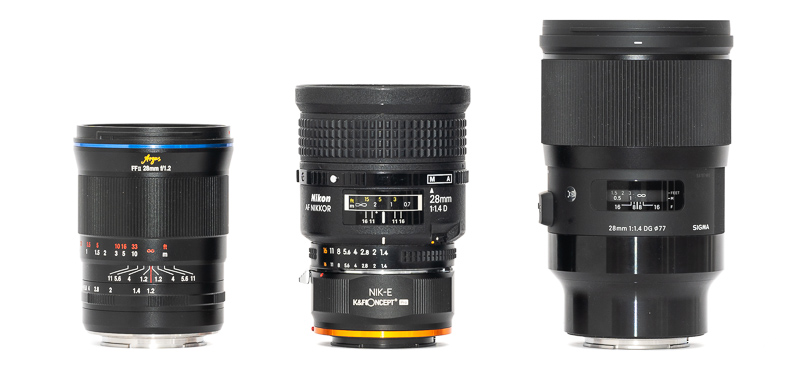
Already on DSLRs this was a big lens, but on mirrorless cameras it is a really big lens, very similar to the Sigma 35mm 1.2 Art DG DN. The Nikon AF 28mm 1.4 D is noticeably smaller, but also not an as complex design. The Laowa 28mm 1.2 Argus is the only lens among these three that has actually been designed for mirrorless cameras. Making use of that advantage it is by far the most compact – despite also being the fastest.
AF performance
I am not shooting sports or fast moving animals/humans so if you want to know if the lens is fast enough for this or how it compares to other lenses in this segment you may have to look for a different review with a more detailed assessment of this aspect.
In everyday use I found the AF to be perfectly fine and accurate.
Vignetting
light falloff
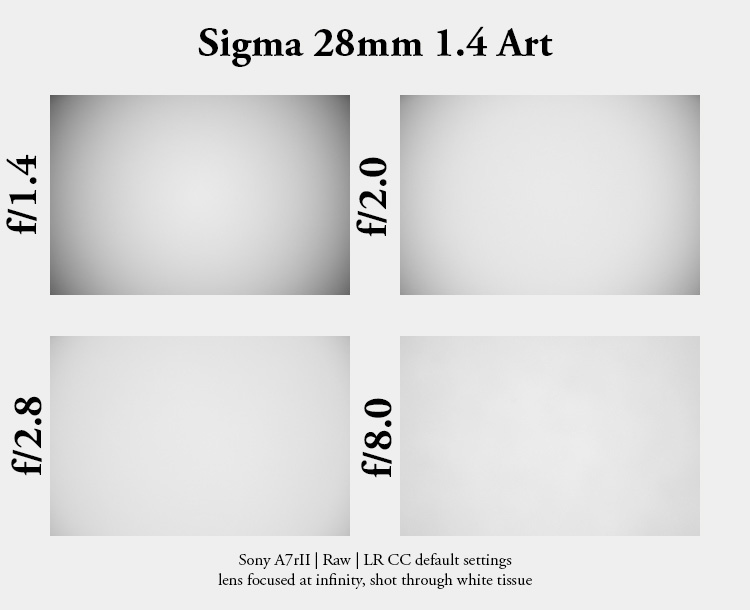
| f/1.4 | 2.8 EV |
| f/2.0 | 2.1 EV |
| f/2.8 | 1.3 EV |
| f/4.0 - f/16 | 0.7 EV |
In this category lenses designed for (D)SLRs actually have a potential benefit over those designed for rangefinder/mirrorless cameras: the long back focus distance can lead to light rays coming from the rear element hitting the sensor at less acute angles. To some degree this is also the case here.
The vignetting figures at the maximum aperture are comparable to those of the Nikon AF 28mm 1.4 D, 7Artisans 28mm 1.4 and also the Laowa 28mm 1.2 @ 1.4, but stopped down this Sigma shows the least vignetting. About a third of a stop less than the Nikon but one stop less than the other two.
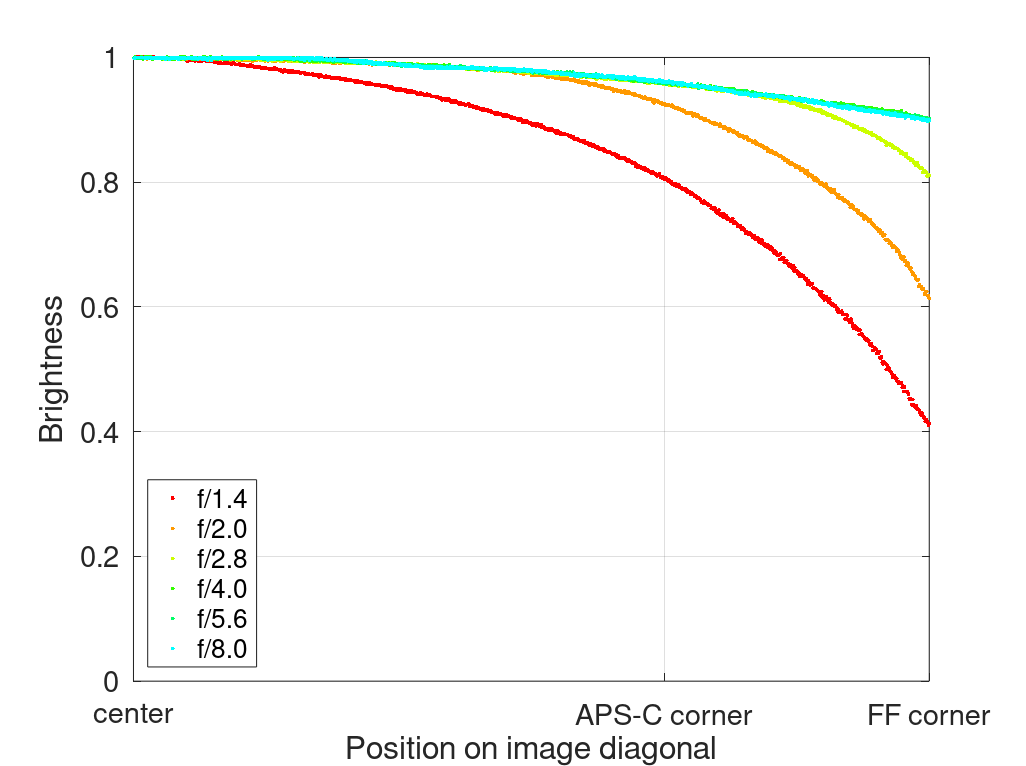
It is recommended to have a look at this article first to get an idea how this brightness graph works.
optical vignetting
Fast lenses usually show a noticeable amount of optical vignetting. Without going too much into technical details optical vignetting leads to the truncation of light circles towards the borders of the frame.
In the center of the frame almost every lens will render a perfect circle, but only lenses with very low optical vignetting will keep this shape in the corners.
So in the following comparison we move from the center (left) to the extreme corner (right) and see how the shape of the light circle changes.
I did shoot all these lenses at the same focus distance, so the size of the circles should be directly comparable.
People sometimes think that big lenses will automatically do well in this category, but quite often this is actually not the case. The amount of optical vignetting is a bit less than that of the Nikon AF 28mm 1.4 D, but the shape in the corners is more lemon-like with the Sigma whereas they are closer to a circle with the Nikon lens. The Laowa 28mm 1.2 actually shows the least optical vignetting, mainly because it is the only lens among those that has been designed for mirrorless cameras, which can be an advantage here.
All three lenses make use of aspherical elements that can lead to onion ring structures in out of focus highlights. Here the Laowa looks best to me and the Nikon worst – with the Sigma inbetween.
Sharpness
MTF-Graphs
The MTF graphs promise an impressive performance at f/1.4 over the central part of the frame up to the inner midframe. When moving more than 10 mm from the center of the sensor, astigmatism starts to appear which then disappears in the corners. This might be one of those lenses where we need to have a closer look at the outer midframe area.
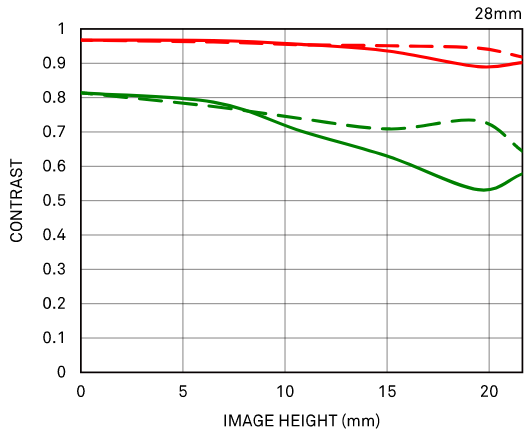
Most MTF-Graphs show calculated values that do not take into account manufacturing tolerances and sample variation. Furthermore they are usually calculated for infinity, so in the field and shooting at different distances a noticeable variation may be visible.
Focus Shift
I don’t see any focus shift here.
infinity (42mp Sony A7rII)
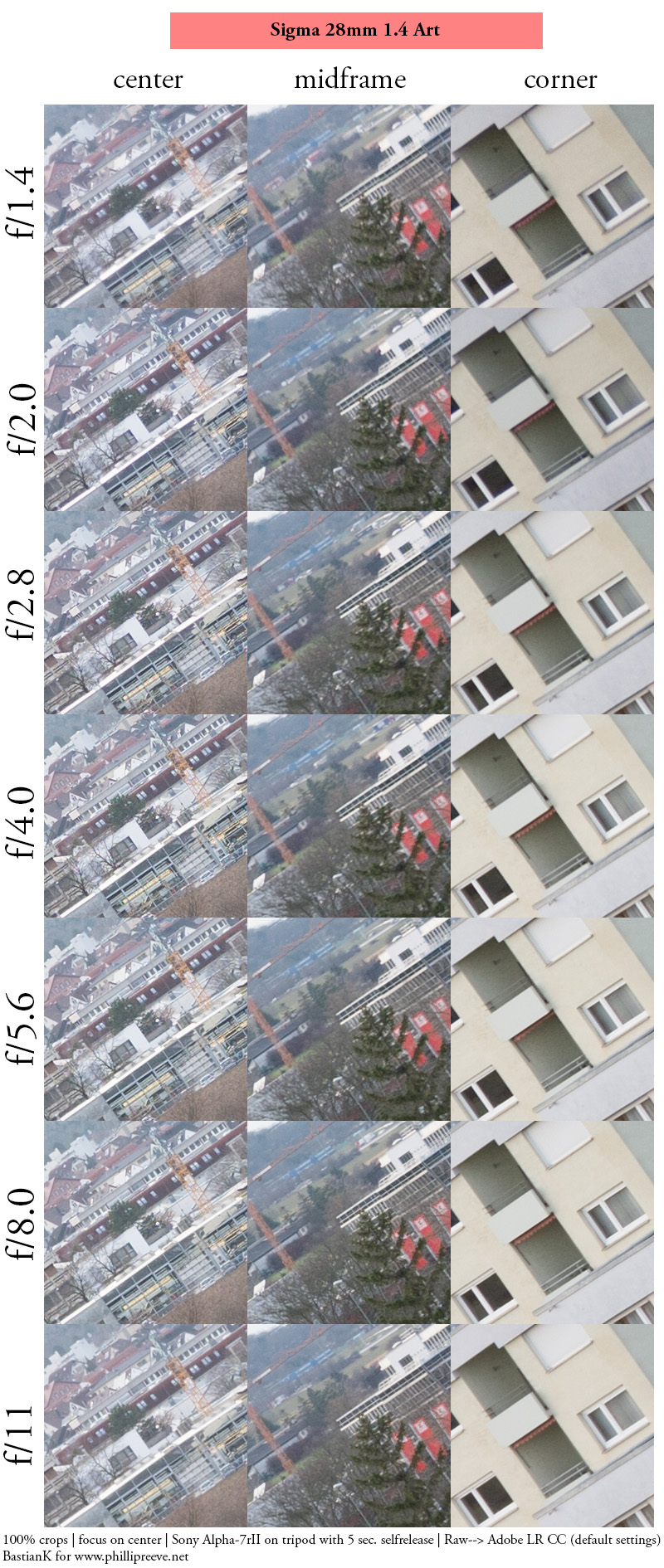
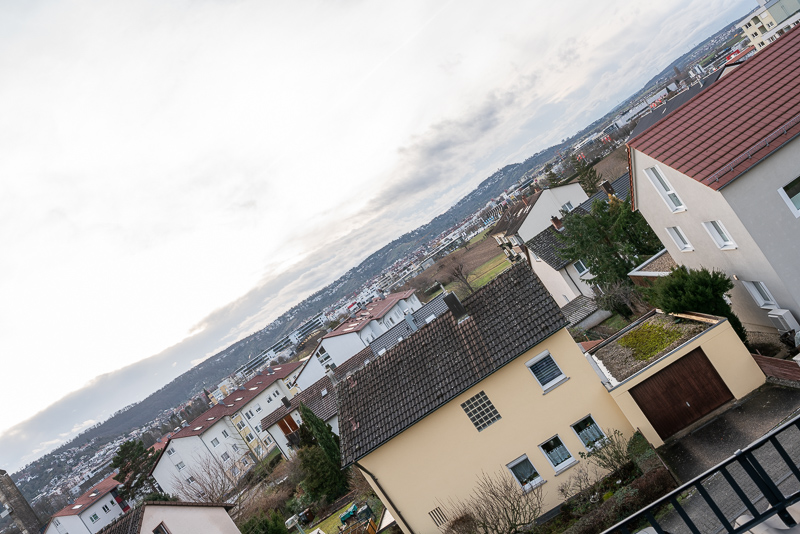
At infinity I see a very good performance from this lens. Center and also corners look great from f/1.4. When it comes to the midframe I am showing you the worst part of the frame and I think this matches the dent in the MTF graphs. Stopped down to f/2.8 already we get very good across frame performance.
The Nikon AF 28mm 1.4 D is not a contestant here. The 7Artisans 28mm 1.4 FE+ also shows a worse performance in the midframe and corners and needs to be stopped down to f/5.6 for very good across frame sharpness. The Laowa 28mm 1.2 also looks very good from f/2.8.
When it comes to 28mm 1.4 lenses with AF, this is probably the best you can get right now. However, looking at the Sigma 35mm 1.2 Art DG DN, I wonder what a Sigma 28mm 1.4 that is actually designed for mirrorless cameras would be capable of.
portrait distance 0.9 m (42mp Sony A7rII)
For portraiture it isn’t so important how flat the field is, it is more interesting to see what the sharpness is like when focused at different parts of the frame to take field curvature out of the equation.
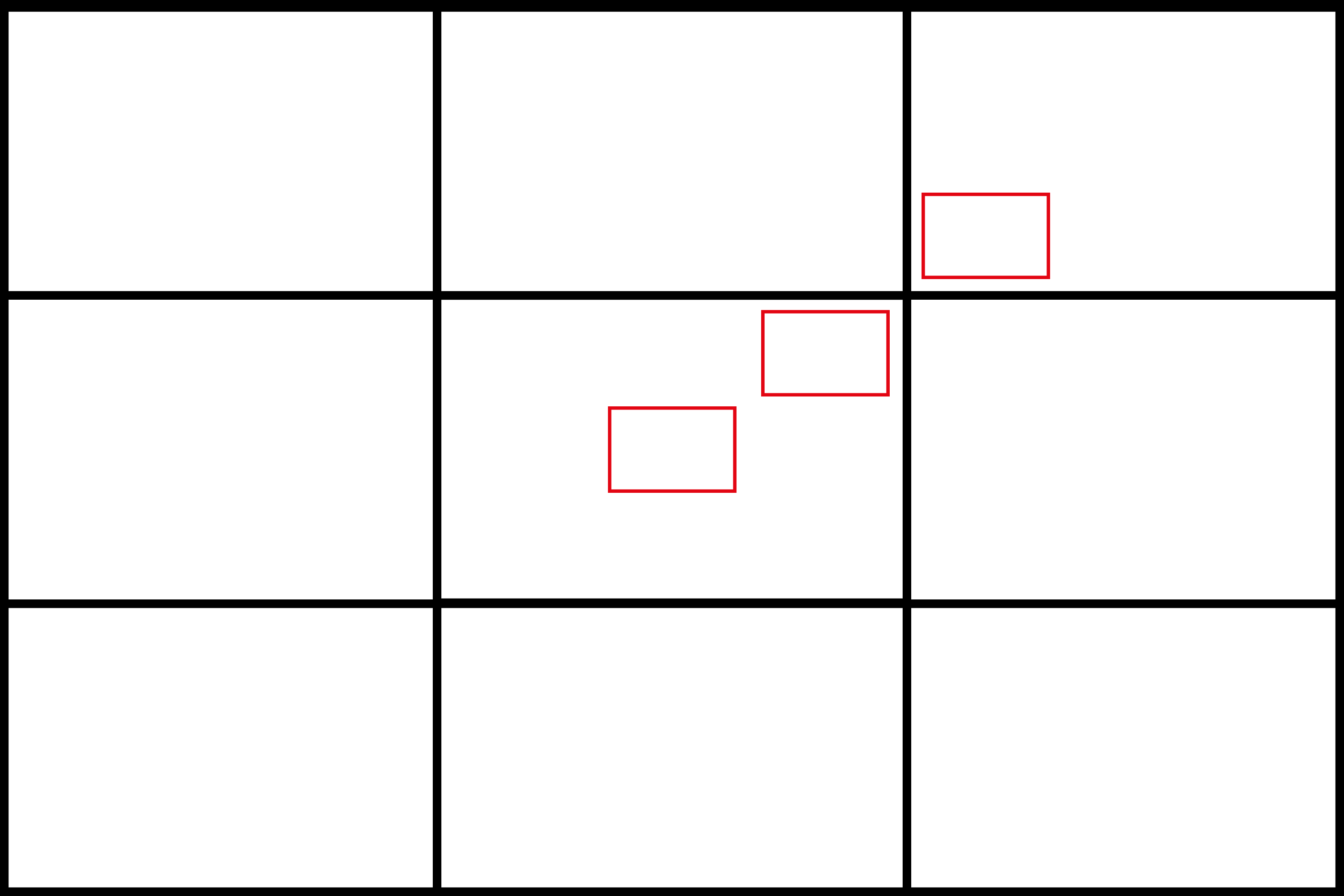
This is what I did here, I refocused for every shot and aperture to get the best possible result at different locations in the frame (center, inner midframe and outer midframe).
Focus distance was roughly 0.9 m and the circle of the dollar bill is more or less the size of a human eye.
f/1.4 <————> f/2.0
It actually looks to me like this Sigma 28mm 1.4 has not been optimized for this distance. In the center and inner midframe the performance is good at f/1.4, but not great. In the outer midframe it even looks slightly soft. Stopping down to f/2.0 makes a visible difference and should be sufficient for pretty much anything.
Here a comparison to the Sigma 35mm 1.2 Art DG DN is very interesting though, as the 35mm lens is similarly sized and only slightly heavier. Despite being half a stop faster it leaves the 28mm completely in the dust in this category, as it shows Moiré everywhere in the frame from f/1.2. Even stopped down to f/2.0 the 28mm does not look as impressive as the 35mm at f/1.2.
Coming back to the 28mm lenses, the much older Nikon AF 28mm 1.4 D is noticeably softer. The Laowa 28mm 1.2 on the other hand shows a very similar performance, it might even be contrastier in the midframe area.
close 0.28 m, 1:4.6 (42mp Sony A7rII)
Something I didn’t like about the Laowa 28mm 1.2 and the 7Artisans 28mm 1.4 were their mediocre minimum focus distances of 0.5 and 0.7 m. This Sigma 28mm 1.4 Art actually has the best minimum focus distance of all of them (0.28 m), also surpassing the Nikon AF-D 28mm 1.4 (0.35 m). What is interesting here is that despite the difference in minimum focus distance being only 0.07 m, this Sigma offers a much higher magnification – almost double that of the Nikon lens.
At f/1.4 I see a lot of spherical aberration at this distance – similar to the aforementioned Nikon lens – stopping down to f/2.0 improves the performance considerably and stopping down to f/2.8 even more so.
Flare resistance
As always evaluating flare is a complex matter since you can get any lens to look bad if you push it hard enough and a slight change of scenario can affect results a lot.
We will see how the lens performs wide open as well as stopped down with the sun in different positions relative to the camera:
At f/1.4 the performance is actually surprisingly good. We can see some faint artefacts, especially with the sun outside the frame and some small faint ghosts with the sun inside the frame, but nothing that really has the potential to ruin your pictures.
Now stopped down we can find all kind of colorful and distracting artefacts, no matter whether the sun is located inside or outside the frame. Only with the strong point light source located close to the center of the frame there are hardly any issues.
None of the fast 28mm lenses I have used so far fared well in this category.
Coma
The corners are not perfectly clean from Coma at f/1.4, but this is still the best performance from a 28mm 1.4 lens I have seen in this category so far. The 7Artisans 28mm 1.4 does come close though and the Laowa 28mm 1.2 looks least as good from f/2.0. The older Nikon AF 28mm 1.4 D does not stand a chance.
Distortion
The Sigma 28mm 1.4 shows some barrel distortion which is easily visible with straight lines close to the edges of the frame. A correction profile in Lightroom is available which is doing a good job at correcting this.
Bokeh
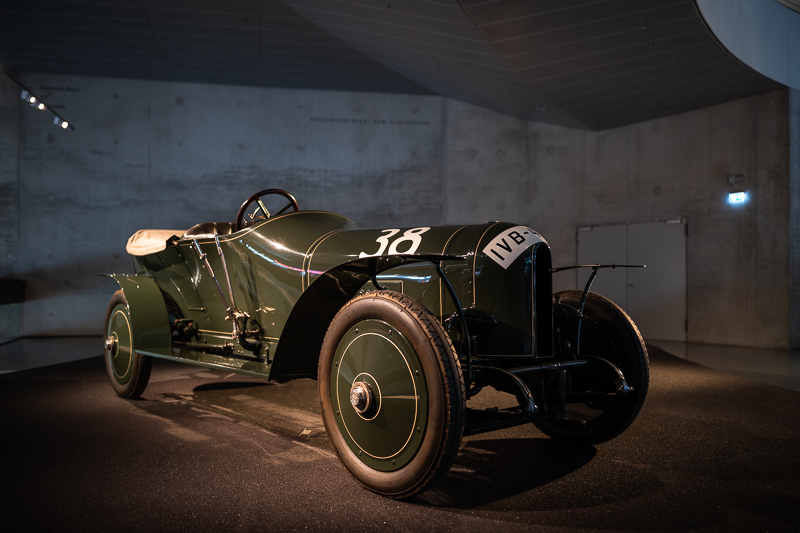
As usual we will have a look how the lens performs at different distances and in different scenarios.

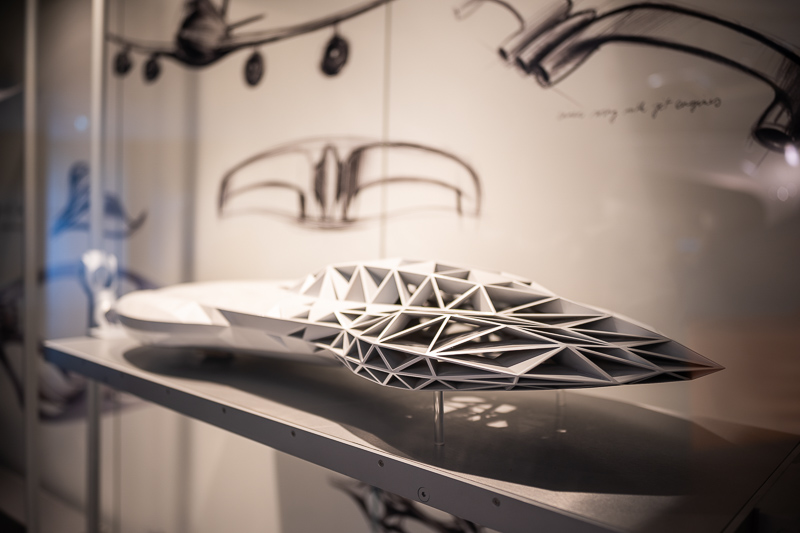
On paper this Sigma has the same minimum focus distances as the Nikon AF-S 28mm 1.4E, but it actually features the highest magnification of 1:4.6.
Thanks to the floating elements design sharpness and contrast are very good at all distances.
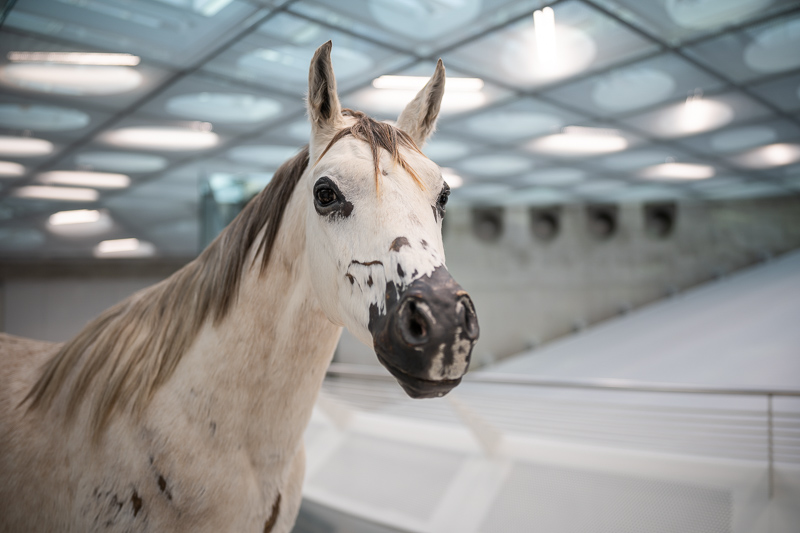

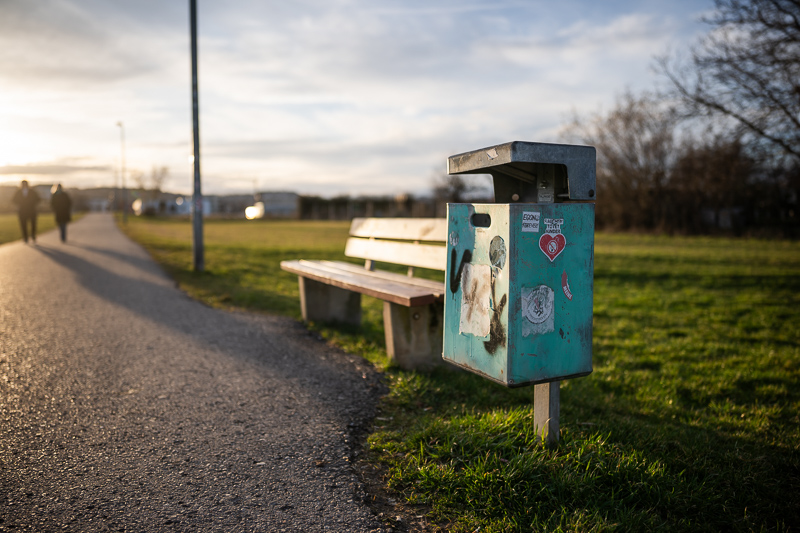
Mid distances are what I like to use lenses like this for the most, because you can show a person but also its slightly out of focus surroundings (see: How to: Create Environmental Portraits).
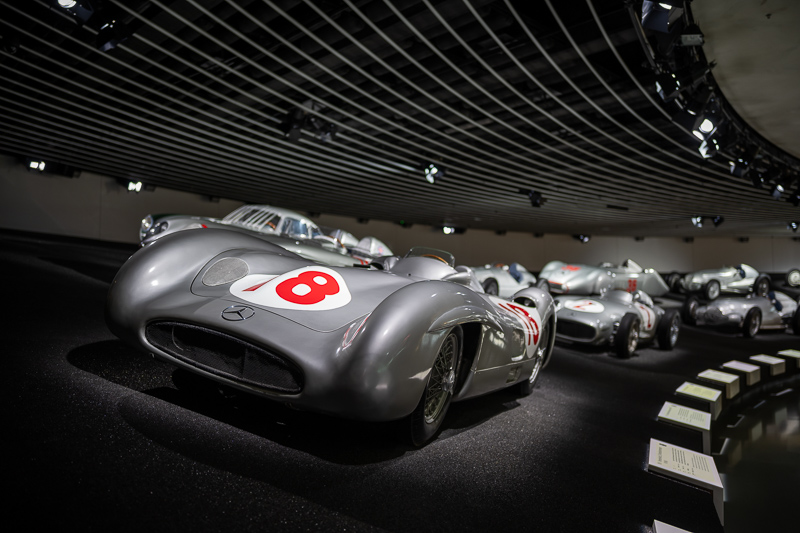
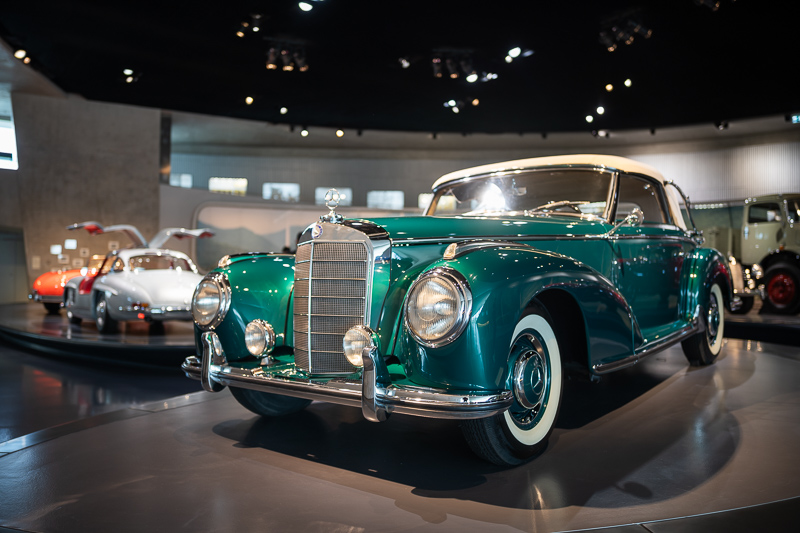
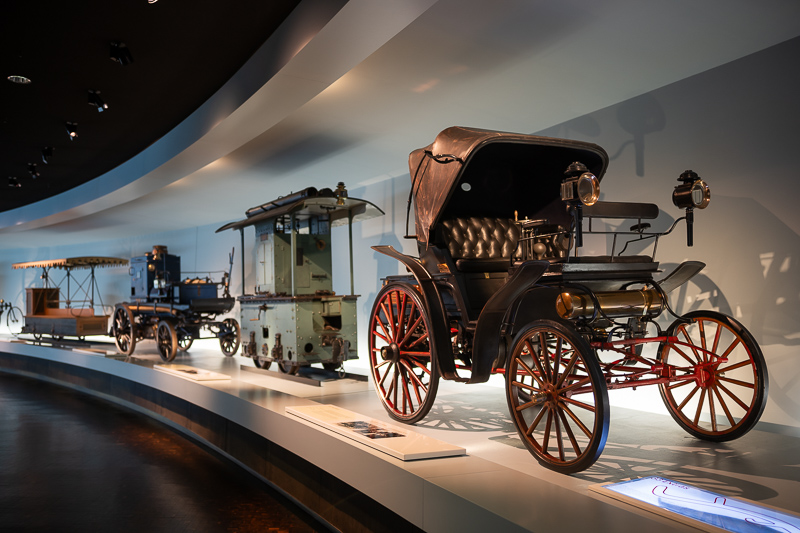
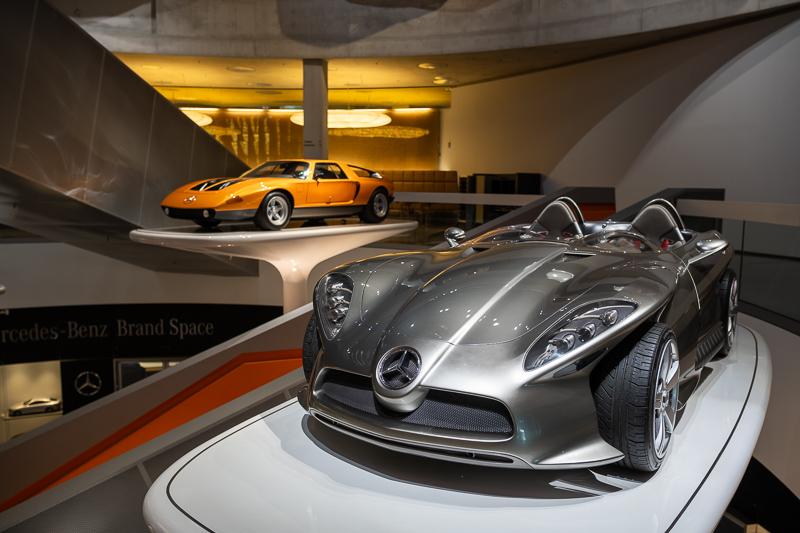

Regular readers know that this is where things get interesting. The Laowa 28mm 1.2 Argus is a lens that showed a great performance at close to mid distances, but had some issues caused by field curvature at longer distances. For this Sigma lens, this is not the case. I compared it directly to the Laowa 28mm 1.2, the Nikon AF-S 28mm 1.4E as well as the older AF 28mm 1.4D and also the Voigtländer VM 28mm 1.5 Nokton and the Thypoch Simera 28mm 1.4. Check out my comparison of fast 28mm lenses to see for yourself.
In most of the scenes this Sigma lens created the – to my eyes – most appealing bokeh: smooth and undistracting.
Sunstars
For a long time, appealing sunstars weren’t high on Sigma’s ToDo list when designing lenses. Many of their old lenses create really whacky sunstars with undefined rays of uneven length. Some of that still holds true here, but we do get somewhat decent sunstars at f/11 or better f/16. Looking at the sun in the flare resistance section the uneven length of the rays will be more obvious though.
If you want to learn more about this topic have a look at this article.
Chromatic aberration
lateral
Lateral CA are corrected perfectly. There aren’t any I could show you here.
longitudinal
Here the complex optical design certainly pays off. While the Sigma 28mm 1.4 is not free from bokeh fringing, it is at a level that isn’t overly distracting. Stopped down to f/2.8 it is almost completely gone.
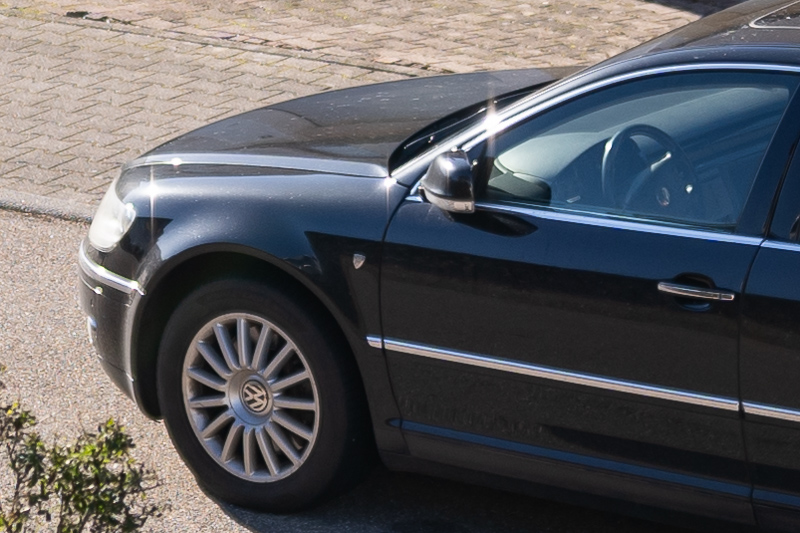
When it comes to purple fringing this lens is perfectly corrected from f/1.4.
Conclusion
good
|
average
|
not good
|
For E, L and EF mount users this is pretty much the only real option with reliable AF (beginning of 2024). Luckily it is also a good option, with only very few downsides, the most relevant being its weight and dimensions. If you can look past that – and the mediocre flare resistance – this lens does not leave a lot to be desired: sharpness is generally good, bokeh is nice, coma correction is good, distortion is easy to correct.
The thing is, the Laowa 28mm 1.2 shows how compact a fast 28mm lens designed for mirrorless cameras can be. I know many of you rely on autofocus at this focal length, so the Laowa may not be the lens you are looking for. But when one day either Sigma or Sony or maybe Viltrox releases a 28mm 1.4 lens, this Sigma 28mm 1.4 will suffer the same fate as their 20mm 1.4 and 24mm 1.4 DSLR designs before: overnight it will loose most of its relevance.
But at this point, who knows when or if any manufacturer will ever release a lens like this? And until then, this Sigma is your best option when it comes to fast 28mm lenses with autofocus.
buy from amazon.com | amazon.de | B&H | ebay.com | ebay.de (affiliate links) for $799 (new) or $550 (used)
Alternatives
This Sigma 28mm 1.4 Art, the Nikon AF-S 28mm 1.4E, the Nikon AF-D 28mm 1.4 and the Laowa 28mm 1.2 Argus are all part of my Fast 28mm Comparison, so best have a look there first.
Viltrox FE 28mm 1.8 AF:
This Viltrox lens is a bit slower but still worth mentioning, as it is probably “the next best thing” when looking for a fast 28mm lens with AF. Sharpness is decent and bokeh is nice, but I wasn’t overly happy with the lack of a button or AF/MF switch and in the Sony world it doesn’t look particularly great next to the smaller and often cheaper Sony FE 28mm 2.0. Still, this is a lens worth checking out, especially if you care about nice bokeh.
buy from manufacturer’s shop (use the code “PRnet” for 8% discount) | B&H | ebay.com (affiliate links) for $379
Laowa 28mm 1.2 Argus:
The Laowa is not only the fastest 28mm lens ever made, it is also a true mirrorless design making use of the short flange focal distance of these cameras. Despite being faster and way smaller it matches and sometimes exceeds the performance of this Sigma lens. The most notable difference is that the Sigma offers autofocus though, which the Laowa doesn’t.
buy from manufacturer’s shop | B&H | ebay.com | Amazon.de (affiliate links) for $599
7Artisans 28mm 1.4 FE+:
This was the first 7Artisans lens and it is still a really compelling option. What I don’t like about it is its minimum focus distance of only 0.7 m. Its flare resistance also ain’t great and it produces unappealing sunstars. Compared to this Sigma it is also a bit worse in terms of resolution.
The 7Artisans is an affordable and compact 28mm 1.4 manual focus lens that has way better performance than you might expect.
buy from ebay.com | ebay.de for about $436 (affiliate links)
Nikon AF 28mm 1.4D:
This was the first 28mm 1.4 fullframe lens ever made when it was released in 1994. While it also uses a hand ground aspherical element as well as a very complex floating elements design, it does not match this two decades younger Sigma’s performance in most categories. It also has become a bit of a collector’s item, driving up its used price. For most people not a really good choice.
buy used from ebay.com (affiliate link) starting at $1200
Nikon AF-S 28mm 1.4E:
The successor to the aforementioned lens. One of Nikon’s last lenses designed for the F-mount that therefore comes with an electronic aperture diaphragm. Compared to this Sigma: better flare resistance, similar resolution and contrast. A good choice to use adapted on a Z camera, not so great choice for other camera systems as only very few and costly adapters allow to change its aperture setting.
buy from Amazon.de | B&H | ebay.com for $1799 new / $1000 used (affiliate links)
Sample Images
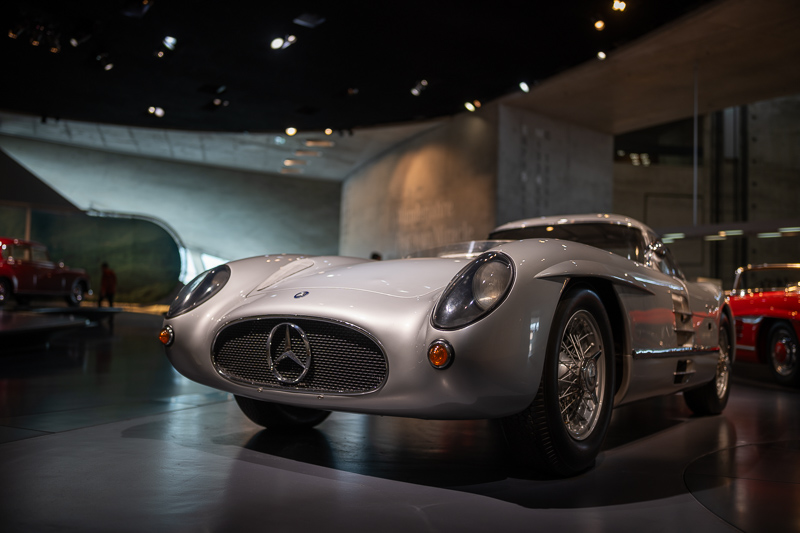
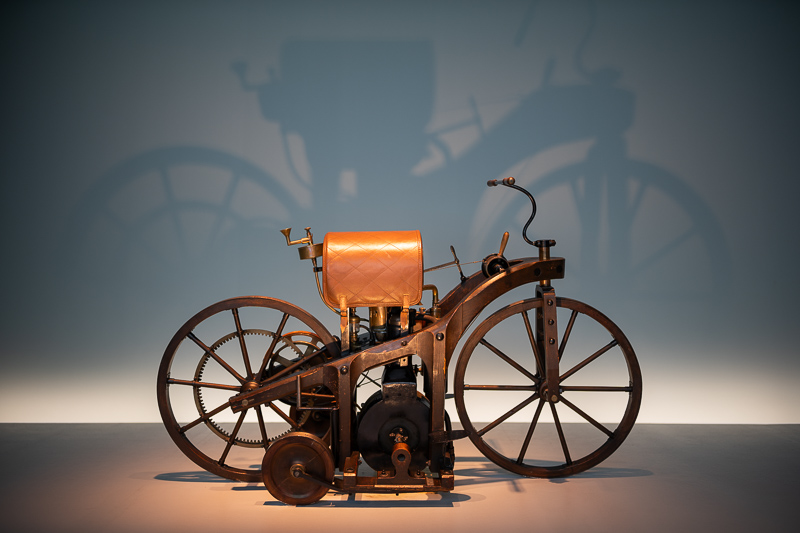
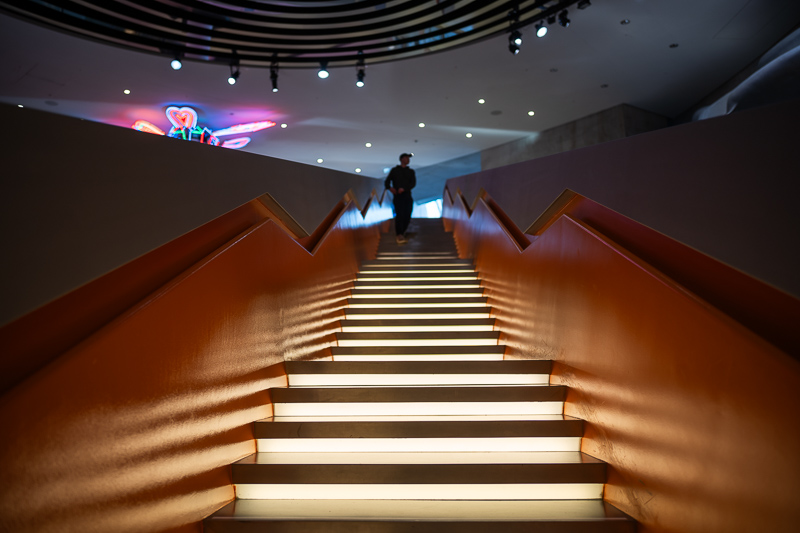
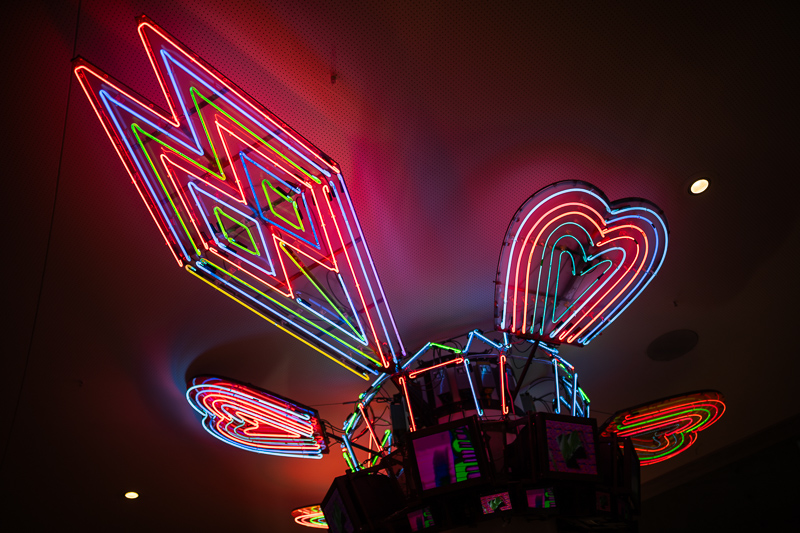

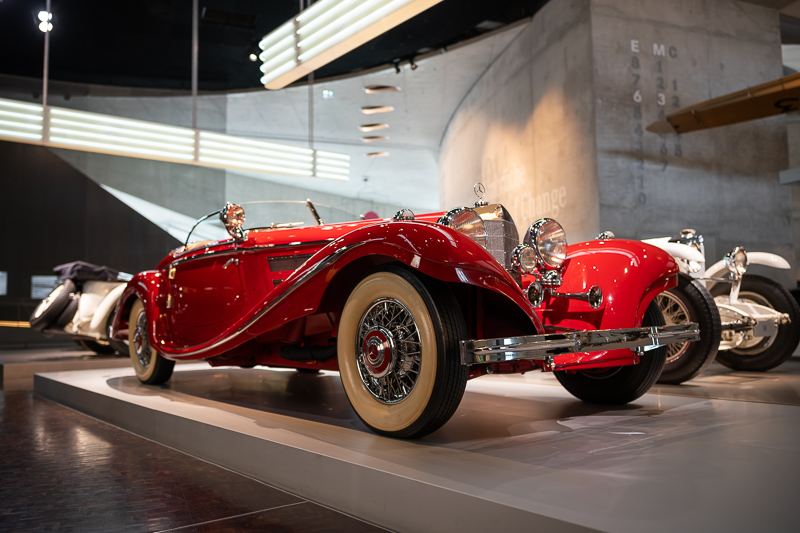


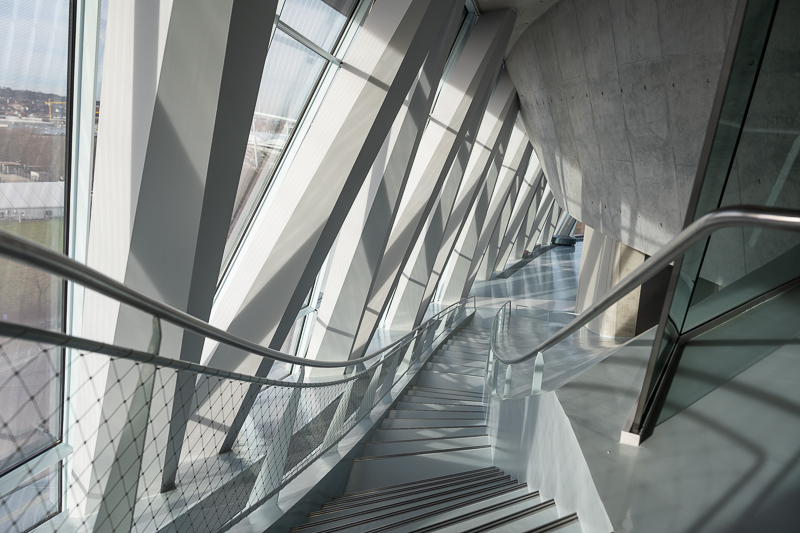
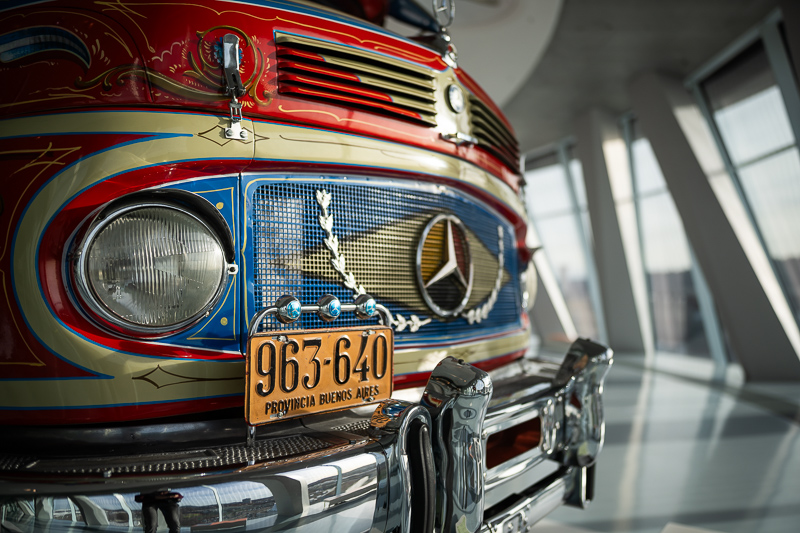
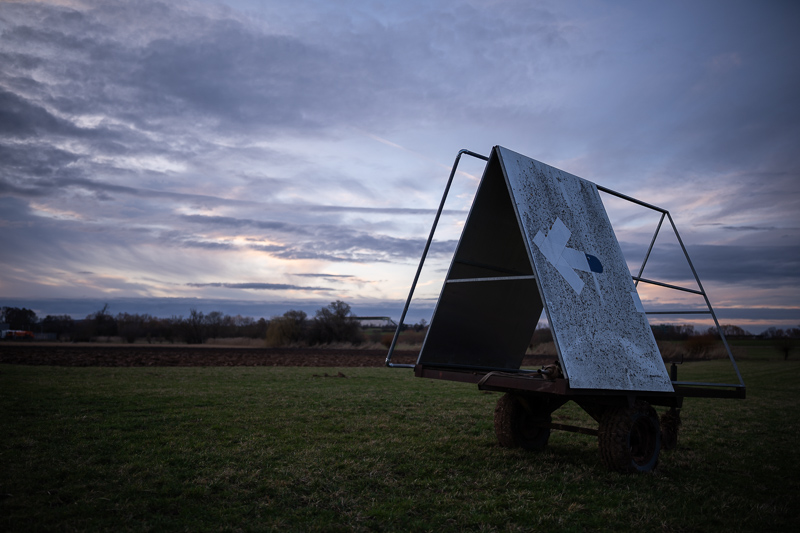
You can find many of the sample images in full resolution here.
Further Reading
- Guide to 20-28mm wide angle lenses for Sony FE cameras
- Review: Zeiss 16mm 8.0 Hologon
- Review: Laowa 35mm 0.95 – The World’s fastest 35mm lens
- What makes a picture good?
- Technical Knowledge
Support Us
Did you find this article useful or just liked reading it? Treat us to a coffee!
![]()
![]()
![]() via Paypal
via Paypal
This site contains affiliate links. If you make a purchase using any of the links marked as affiliate links, I may receive a small commission at no additional cost to you. This helps support the creation of future content.
Latest posts by BastianK (see all)
- Analogue Adventures Part 42: A wedding with Eastman Double-X 200 - July 2, 2025
- Vivo X200 Ultra – The Death of the compact Camera - June 29, 2025
- Review: Laowa 12mm 2.8 AF - June 26, 2025









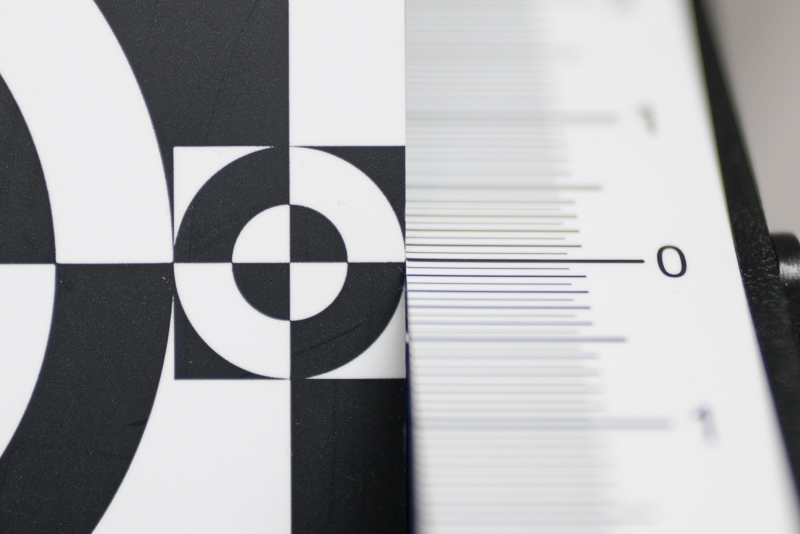
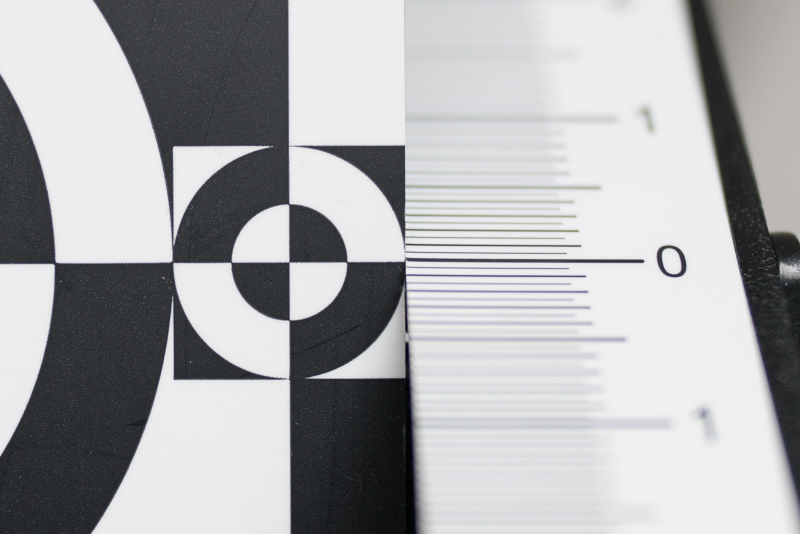
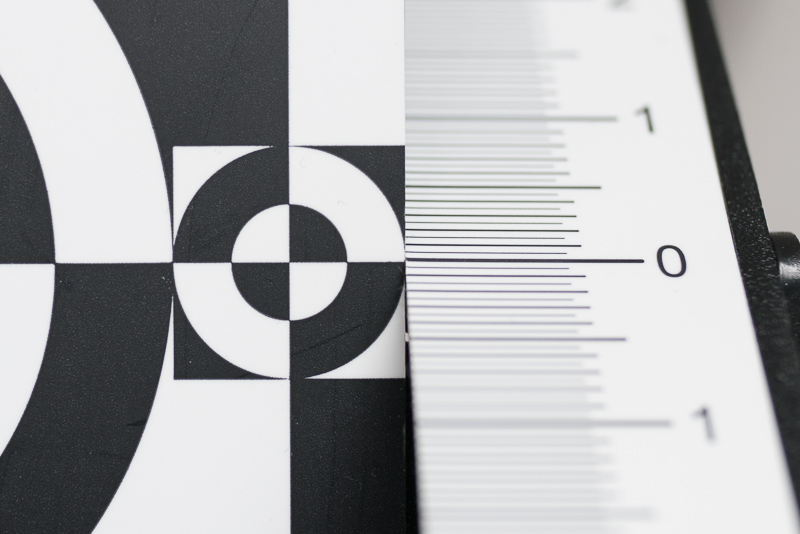
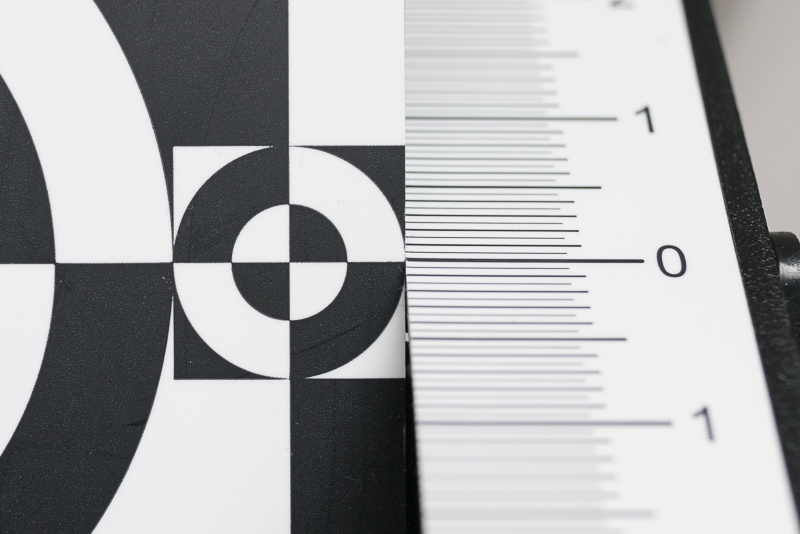
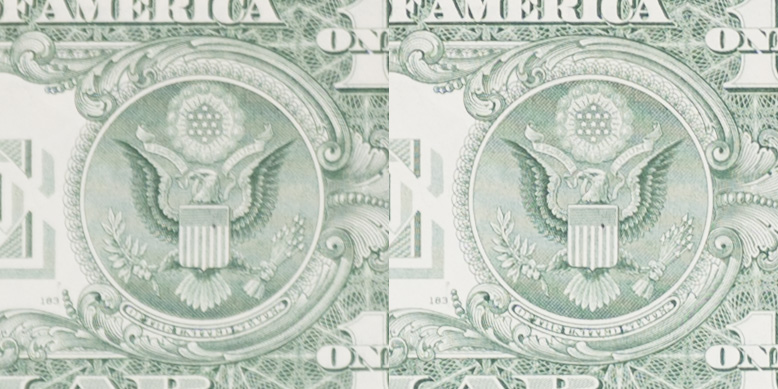
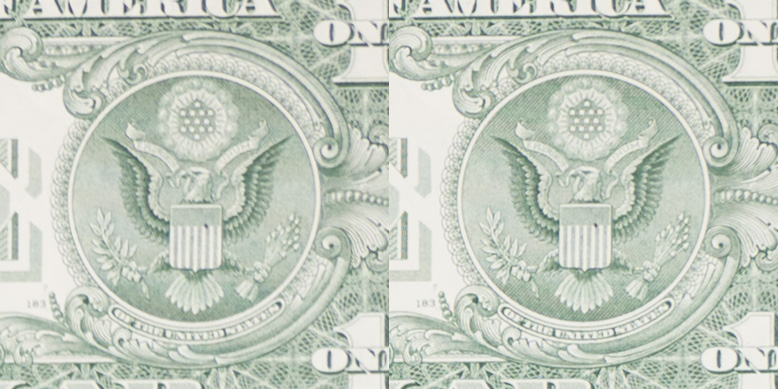
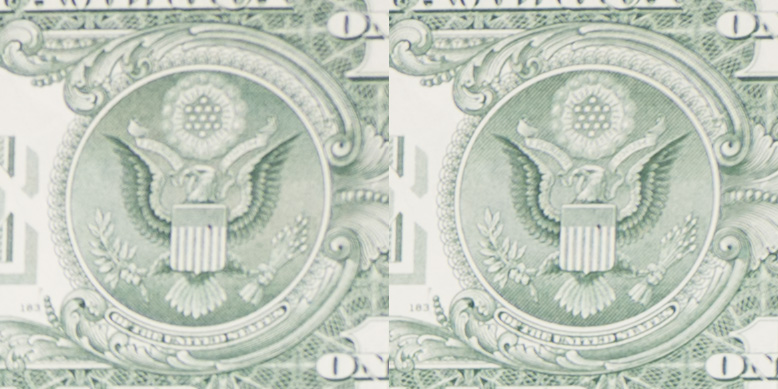




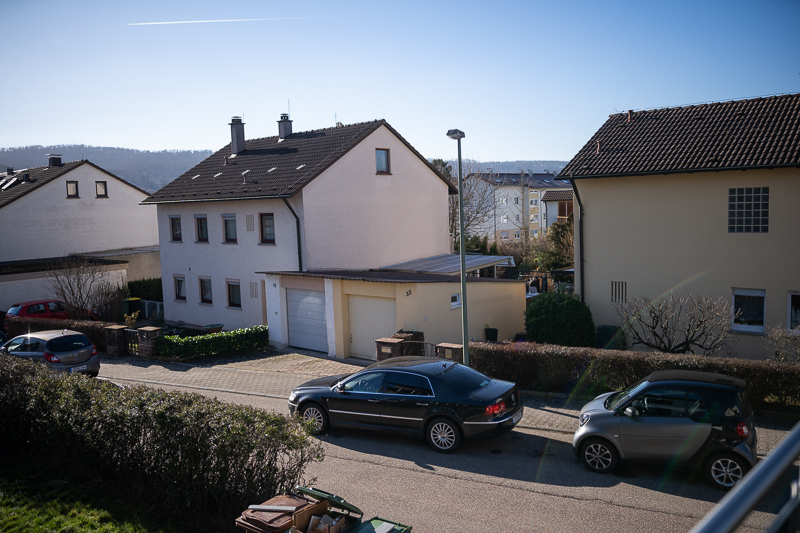
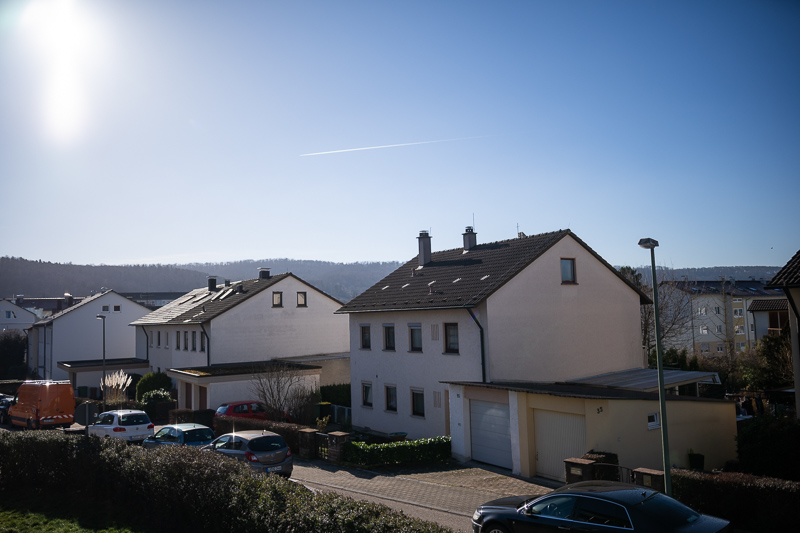
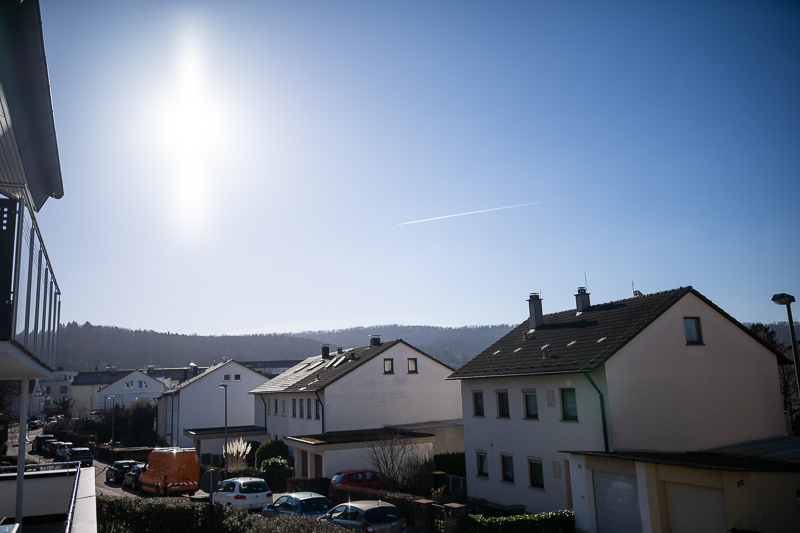
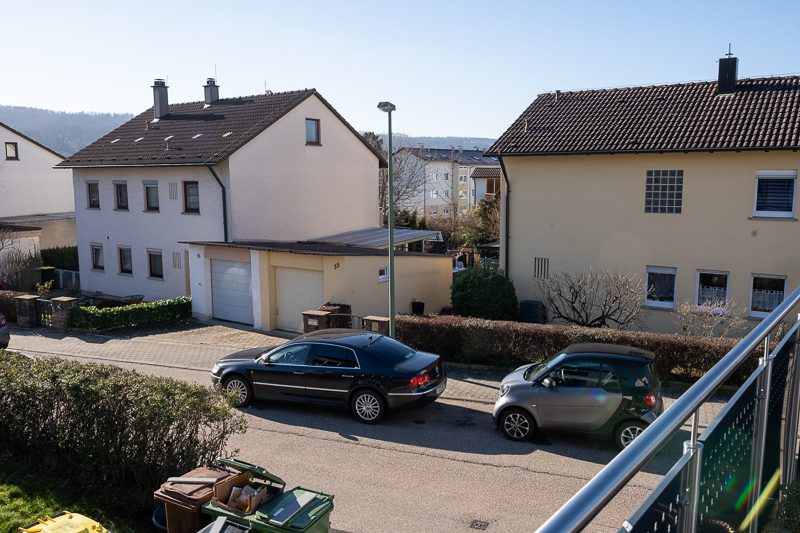
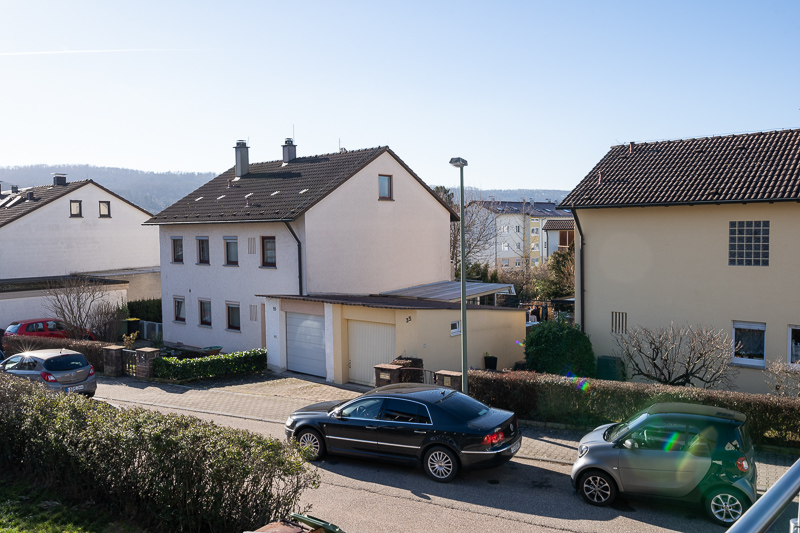
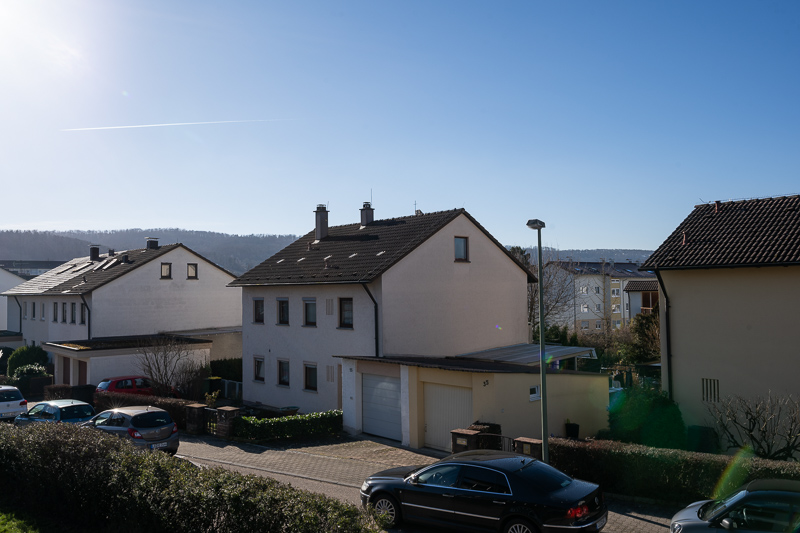
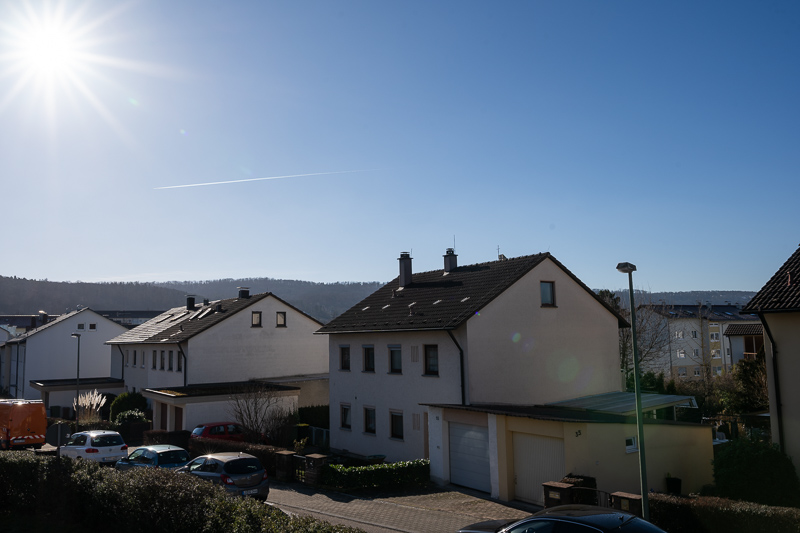
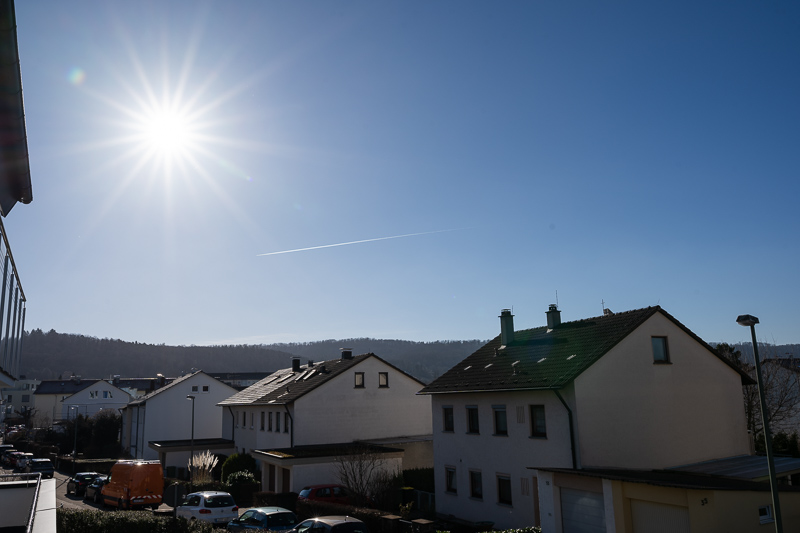
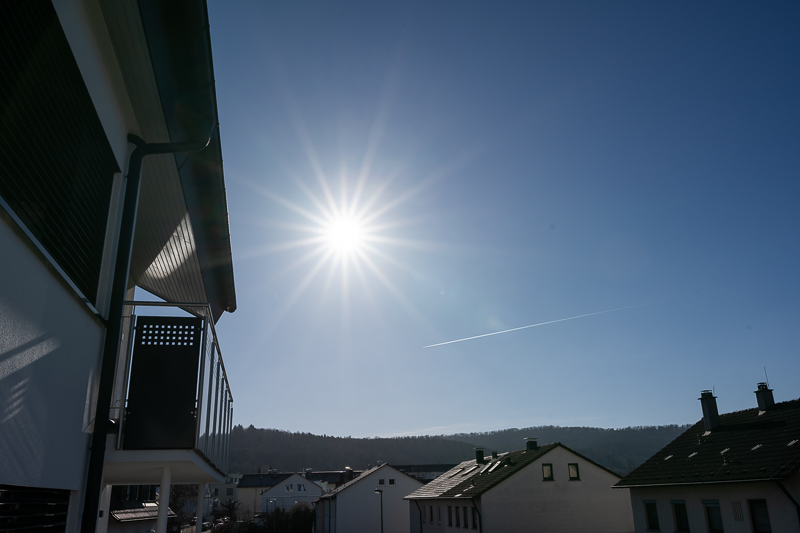
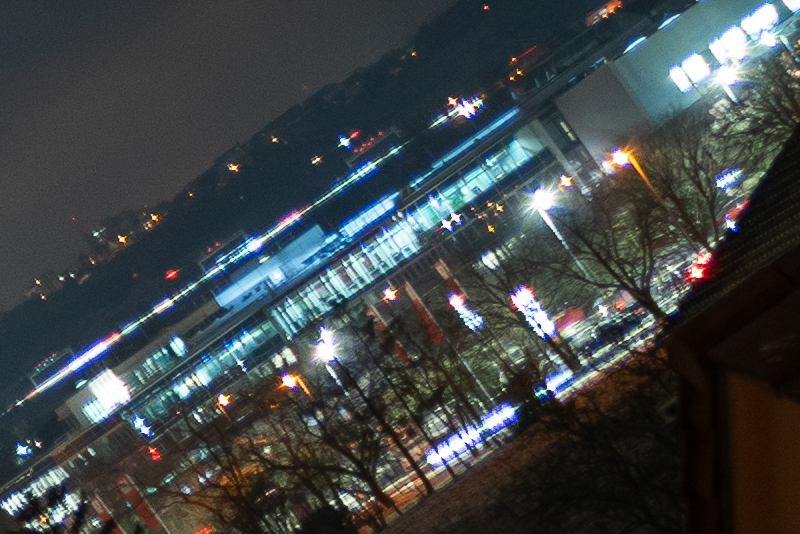
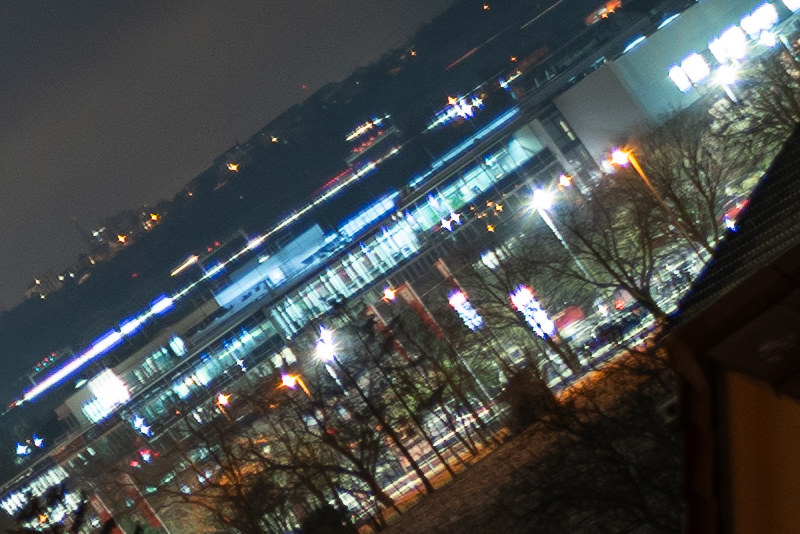
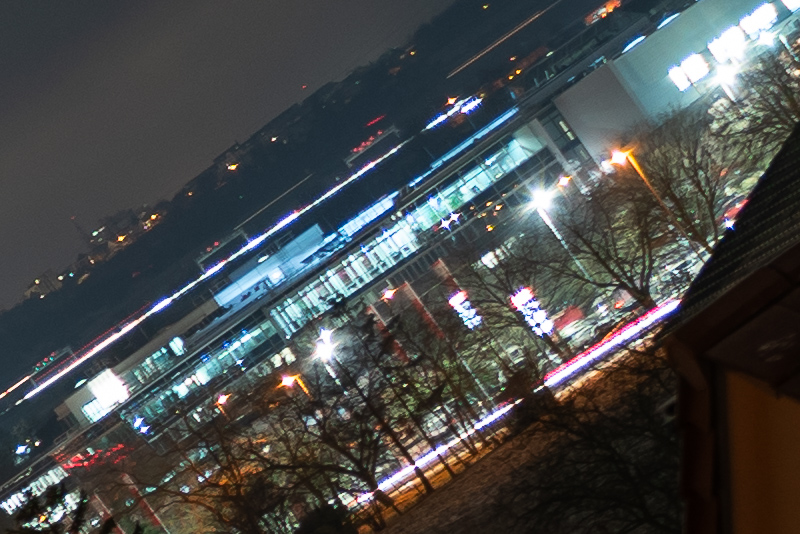
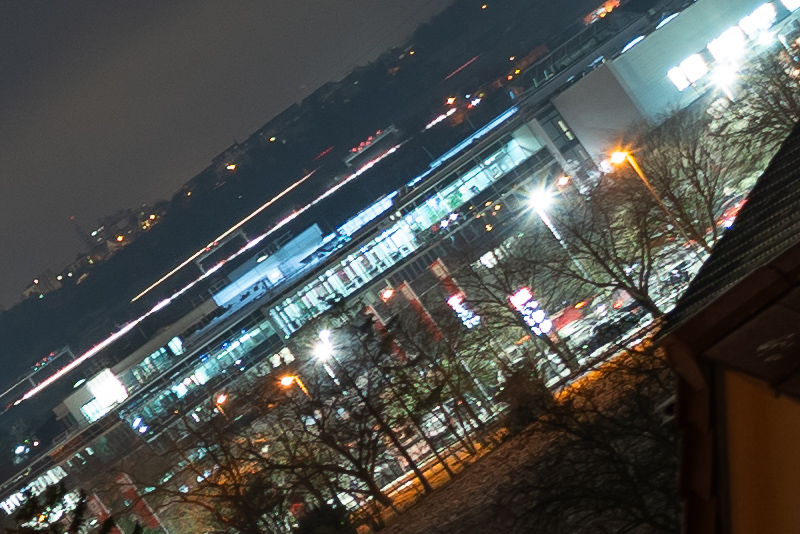
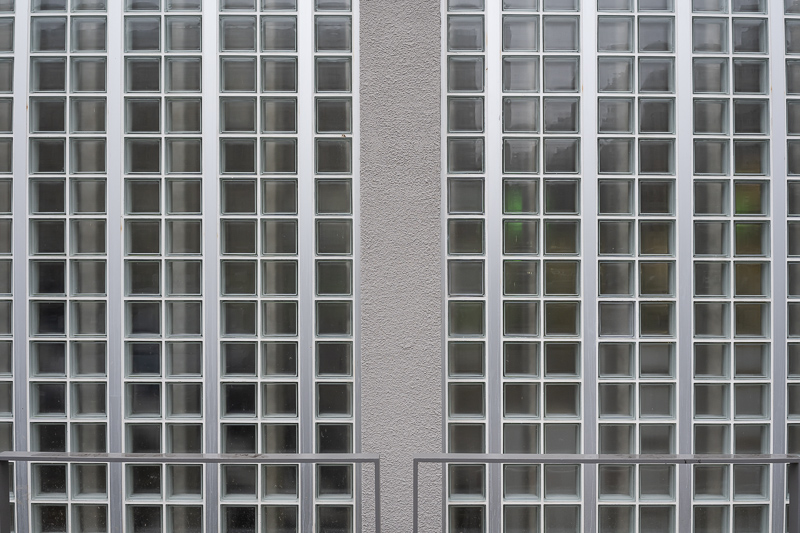
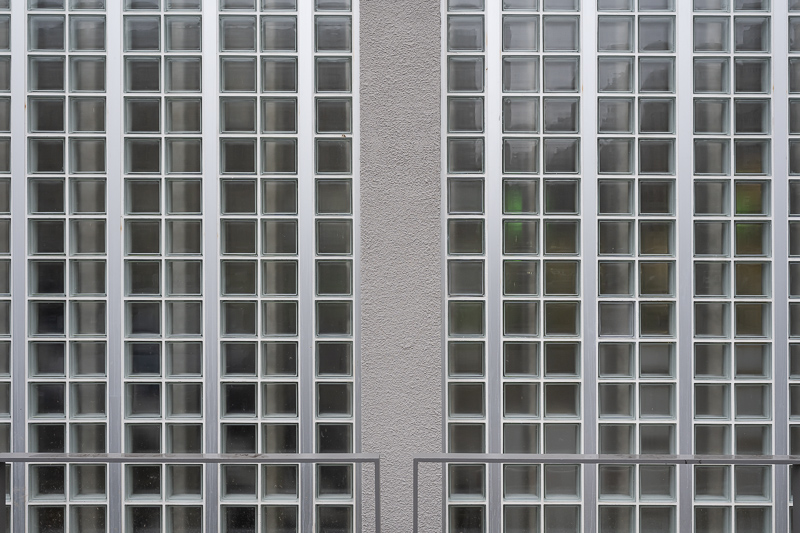
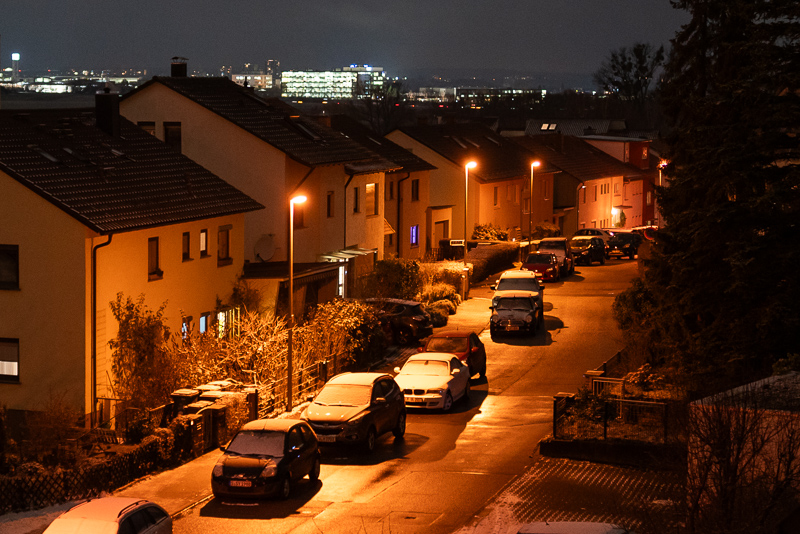
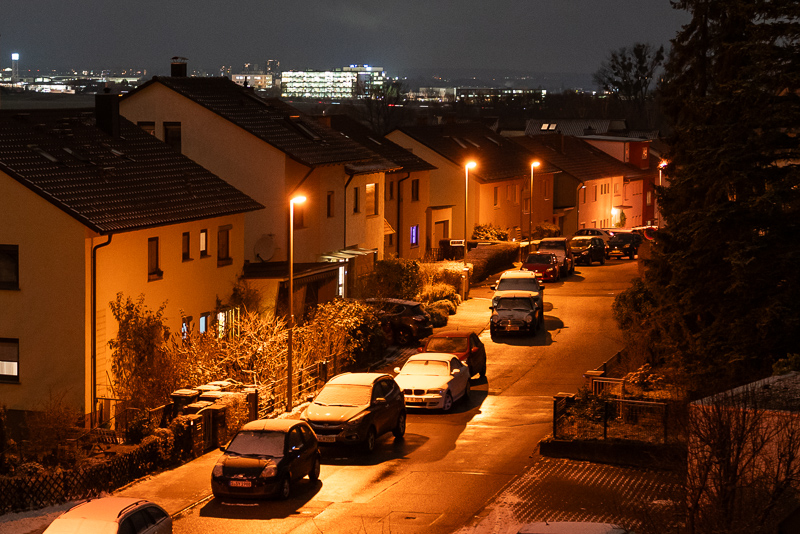
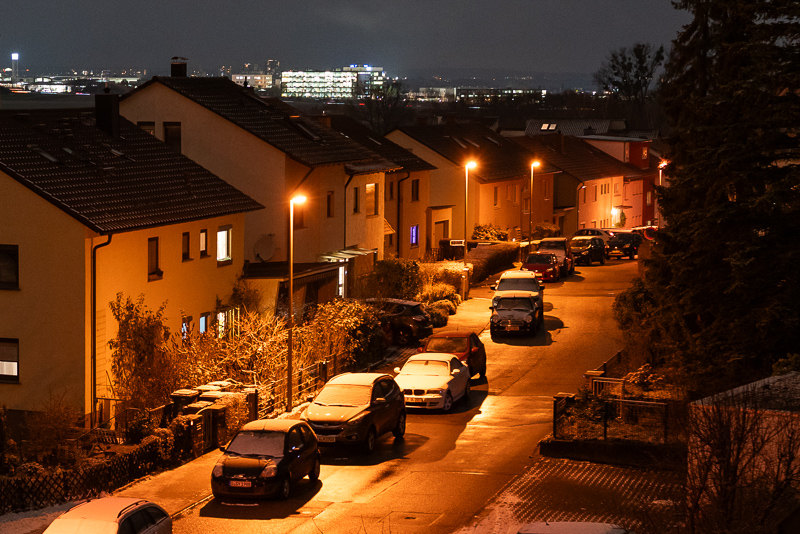
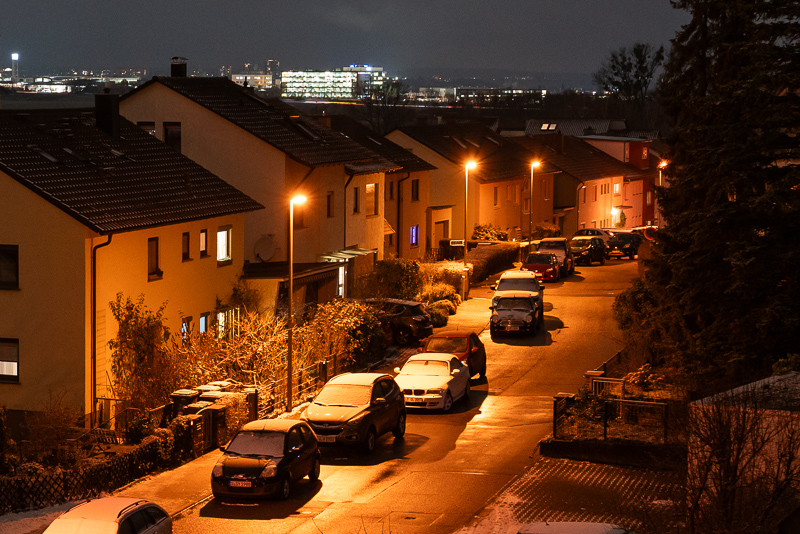
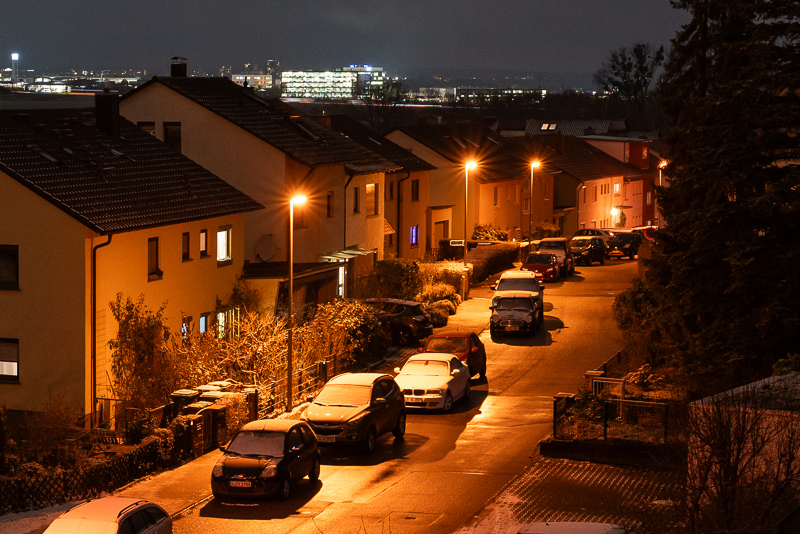
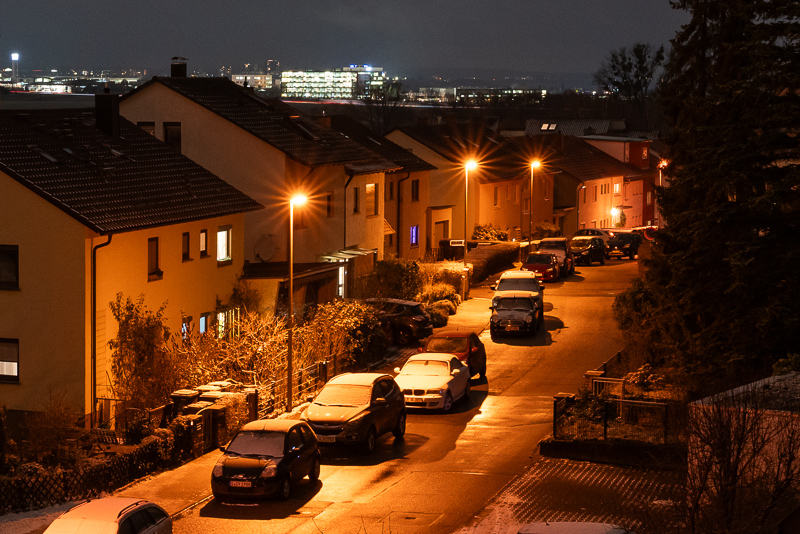
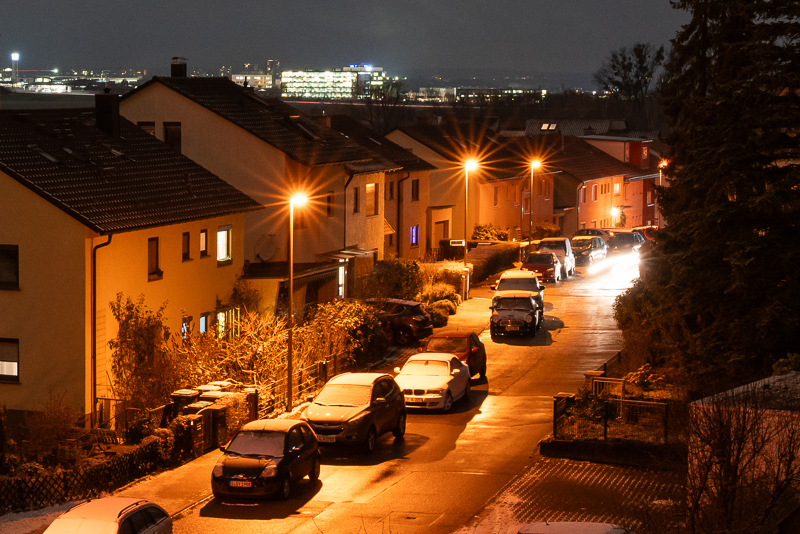
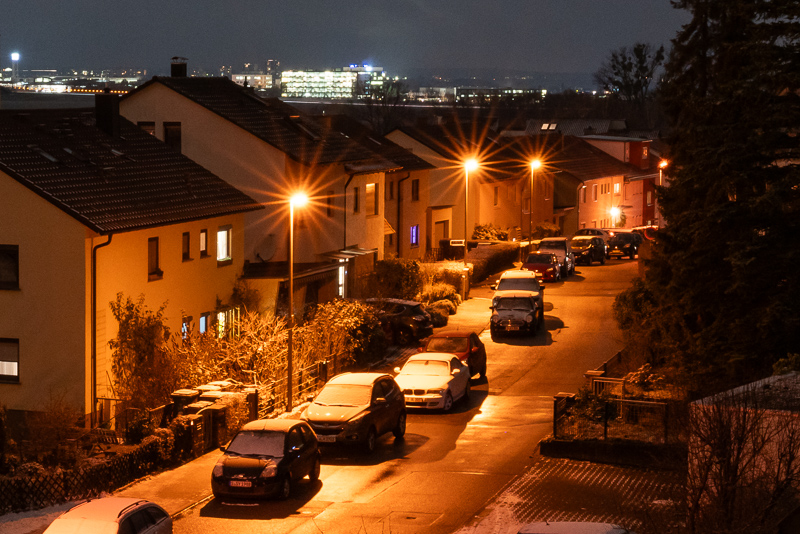
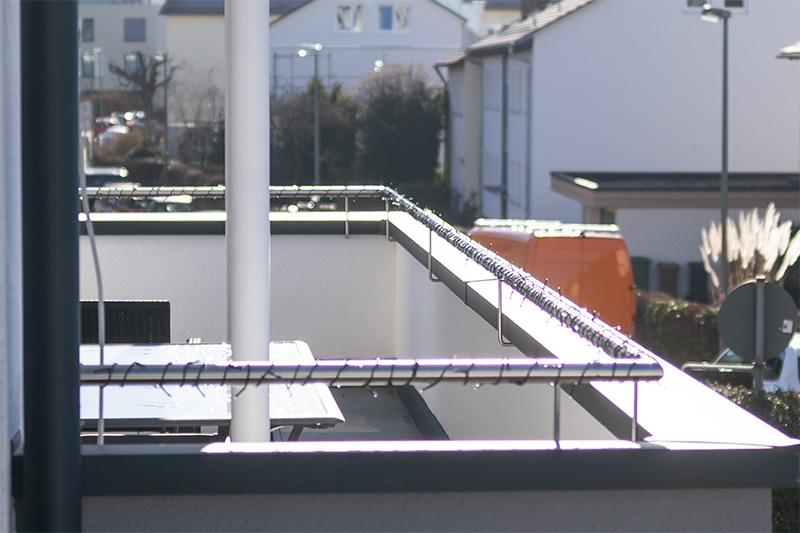
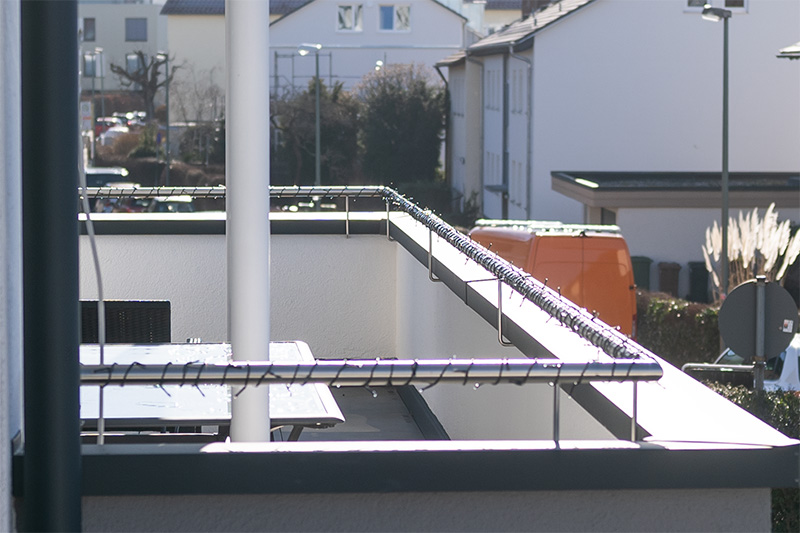
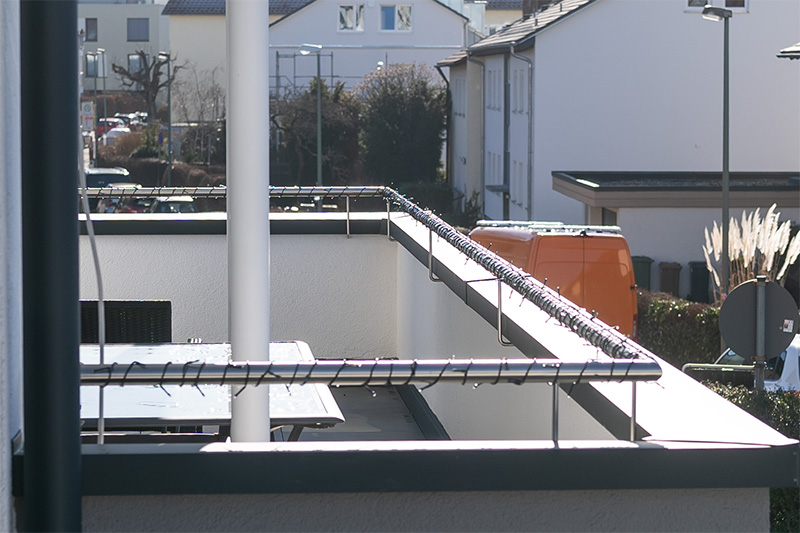
A fine option for discrete street photographers. All jokes aside, there is a point where a lens becomes too big for me to ever wish to use it, especially in more urban areas. I don’t like to draw attention, it’s hard to focus like that, and there’s no AF for that kind of focus…
That’s why I hate using longer tele lenses in the field, but with 28mm I’d sacrifice a few things for sure, just to get a smaller package.
Luckily I’m one of those who prefer MF and avoid AF with anything wider than 85mm so I don’t know why I’m complaining here. It’s just… Seeing this lens on a Sony camera made a huge impression on me (no pun intended).
In terms of rendering it definitely looks better than Laowa and Nikkor., and the price second hand seems reasonable. But the size… 🙂
Being into older Sigma Art series and carrying even a basic set on travels sounds like something Dante would write about.
I did enjoy the review though, and images are nice as always.
Using this 28/1.4 is basically like carrying a 135/1.8 GM around, or a 70-180/2.8, not outlandish but certainly not like the experience of native wide primes.
Indeed. Being a 28mm kind of guy, that’s the one SLR-era lens that I still sometimes adapt to my Sony alphas. It also one of the best if not the best 28mm 1.4 ever made. However, tired of waiting, I eventually gave in and bought a much more practical 24mm 1.4 GM, but I wished it was 28mm…
The problem for me with DSLR adapted (whether with adapter or as in Sigma style) lenses is not the weight or the size since I’m used to managing big glass but the center of gravity is usually too far off.
With an AF lens it’s ok for usability though not the best experience so this Sigma is great I think (especially for Astro use cases where it will be on tripod anyway)
With an adapted big manual focus lens, that really detracts from the experience (example would be bigger Milvus/Otus etc.)
Btw 28mm is a great focal length and one where we don’t have many modern options sadly.
its great for astro scapes/time lapses and even IR on a modified Z6 or my unmodified to Z8.
But yes if they redesign this for mirrorless my guess it would be 40% lighter and 30% smaller, while sacrificing on distorsion and maybe vignetting while maintaining sharpness. In camera correction is what solves those issues… but not for the astro shots where noise pops up in the vignetted corners.
Great lens on DSLR, not a tiny thing but handling is good. Except poor flare resistance, image quality is top notch. The lens was around 1200 € when it was released so it’s quite a bargain today. However I would never try to mount it on mirrorless, way too big.
I’ll be the first to say the most obvious thing about the review images and what they reveal. Congratulations! I hope you are both feeling calm before the gigantic leap of change in your lives occur.
The Sigma 24-45mm f/1.8 DG DN Art could probably be considered an alternative to this lens now as well.
Not a fan of 28mm generally, but several years ago I bought this lens (in EF mount) to adapt to the GFX 50R and found it covers about 95% of the sensor at infinity focus. I’ve used it for astro and wide angle environmental portraiture where it might just be the best option going for medium format (22mm f1.1 equivalent). I also enjoy the Sigma 105/1.4, and plan to eventually pick up the 135 and 40 Art lenses to adapt as well.